Orbifolds of M-Theory and Type II String Theories in Two Dimensions
- 格式:pdf
- 大小:203.79 KB
- 文档页数:25
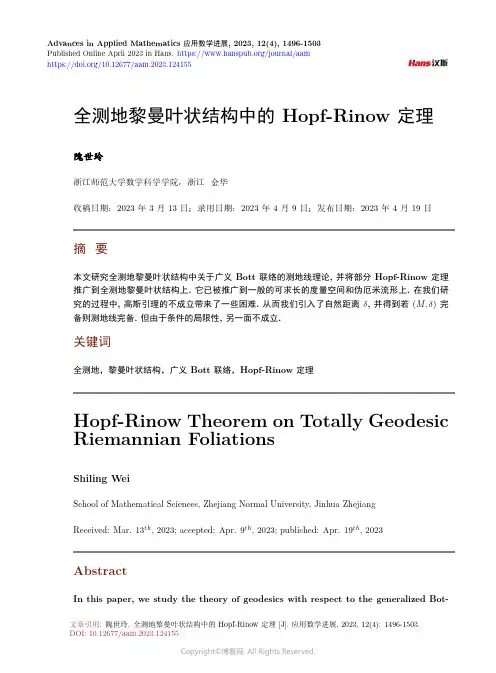
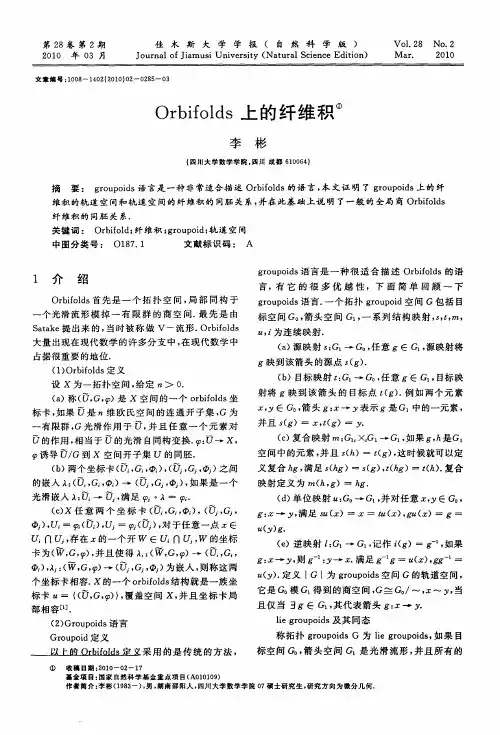
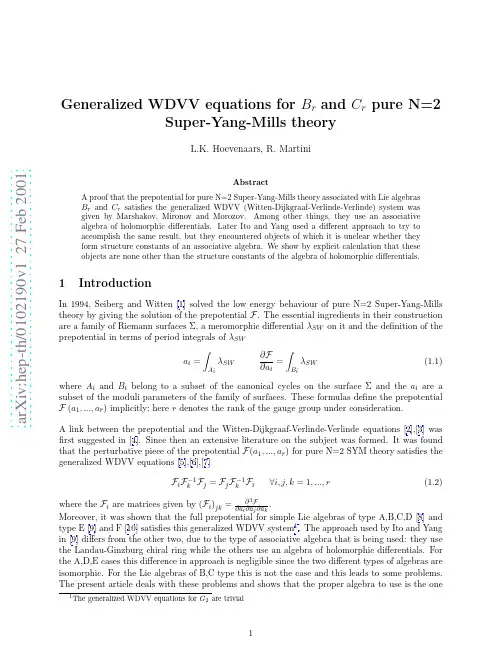
a r X i v :h e p -t h /0102190v 1 27 F eb 2001Generalized WDVV equations for B r and C r pure N=2Super-Yang-Mills theoryL.K.Hoevenaars,R.MartiniAbstractA proof that the prepotential for pure N=2Super-Yang-Mills theory associated with Lie algebrasB r andC r satisfies the generalized WDVV (Witten-Dijkgraaf-Verlinde-Verlinde)system was given by Marshakov,Mironov and Morozov.Among other things,they use an associative algebra of holomorphic diffter Ito and Yang used a different approach to try to accomplish the same result,but they encountered objects of which it is unclear whether they form structure constants of an associative algebra.We show by explicit calculation that these objects are none other than the structure constants of the algebra of holomorphic differentials.1IntroductionIn 1994,Seiberg and Witten [1]solved the low energy behaviour of pure N=2Super-Yang-Mills theory by giving the solution of the prepotential F .The essential ingredients in their construction are a family of Riemann surfaces Σ,a meromorphic differential λSW on it and the definition of the prepotential in terms of period integrals of λSWa i =A iλSW ∂F∂a i ∂a j ∂a k .Moreover,it was shown that the full prepotential for simple Lie algebras of type A,B,C,D [8]andtype E [9]and F [10]satisfies this generalized WDVV system 1.The approach used by Ito and Yang in [9]differs from the other two,due to the type of associative algebra that is being used:they use the Landau-Ginzburg chiral ring while the others use an algebra of holomorphic differentials.For the A,D,E cases this difference in approach is negligible since the two different types of algebras are isomorphic.For the Lie algebras of B,C type this is not the case and this leads to some problems.The present article deals with these problems and shows that the proper algebra to use is the onesuggested in[8].A survey of these matters,as well as the results of the present paper can be found in the internal publication[11].This paper is outlined as follows:in thefirst section we will review Ito and Yang’s method for the A,D,E Lie algebras.In the second section their approach to B,C Lie algebras is discussed. Finally in section three we show that Ito and Yang’s construction naturally leads to the algebra of holomorphic differentials used in[8].2A review of the simply laced caseIn this section,we will describe the proof in[9]that the prepotential of4-dimensional pure N=2 SYM theory with Lie algebra of simply laced(ADE)type satisfies the generalized WDVV system. The Seiberg-Witten data[1],[12],[13]consists of:•a family of Riemann surfacesΣof genus g given byz+µz(2.2)and has the property that∂λSW∂a i is symmetric.This implies that F j can be thought of as agradient,which leads to the followingDefinition1The prepotential is a function F(a1,...,a r)such thatF j=∂FDefinition2Let f:C r→C,then the generalized WDVV system[4],[5]for f isf i K−1f j=f j K−1f i∀i,j∈{1,...,r}(2.5) where the f i are matrices with entries∂3f(a1,...,a r)(f i)jk=The rest of the proof deals with a discussion of the conditions1-3.It is well-known[14]that the right hand side of(2.1)equals the Landau-Ginzburg superpotential associated with the cor-∂W responding Lie ing this connection,we can define the primaryfieldsφi(u):=−∂x (2.10)Instead of using the u i as coordinates on the part of the moduli space we’re interested in,we want to use the a i .For the chiral ring this implies that in the new coordinates(−∂W∂a j)=∂u x∂a jC z xy (u )∂a k∂a k )mod(∂W∂x)(2.11)which again is an associative algebra,but with different structure constants C k ij (a )=C k ij(u ).This is the algebra we will use in the rest of the proof.For the relation(2.7)weturn to another aspect of Landau-Ginzburg theory:the Picard-Fuchs equations (see e.g [15]and references therein).These form a coupled set of first order partial differential equations which express how the integrals of holomorphic differentials over homology cycles of a Riemann surface in a family depend on the moduli.Definition 6Flat coordinates of the Landau-Ginzburg theory are a set of coordinates {t i }on mod-uli space such that∂2W∂x(2.12)where Q ij is given byφi (t )φj (t )=C kij (t )φk (t )+Q ij∂W∂t iΓ∂λsw∂t kΓ∂λsw∂a iΓ∂λsw∂a lΓ∂λsw∂t r(2.15)Taking Γ=B k we getF ijk =C lij (a )K kl(2.16)which is the intended relation (2.7).The only thing that is left to do,is to prove that K kl =∂a mIn conclusion,the most important ingredients in the proof are the chiral ring and the Picard-Fuchs equations.In the following sections we will show that in the case of B r ,C r Lie algebras,the Picard-Fuchs equations can still play an important role,but the chiral ring should be replaced by the algebra of holomorphic differentials considered by the authors of [8].These algebras are isomorphic to the chiral rings in the ADE cases,but not for Lie algebras B r ,C r .3Ito&Yang’s approach to B r and C rIn this section,we discuss the attempt made in[9]to generalizethe contentsof the previoussection to the Lie algebras B r,C r.We will discuss only B r since the situation for C r is completely analogous.The Riemann surfaces are given byz+µx(3.1)where W BC is the Landau-Ginzburg superpotential associated with the theory of type BC.From the superpotential we again construct the chiral ring inflat coordinates whereφi(t):=−∂W BC∂x (3.2)However,the fact that the right-hand side of(3.1)does not equal the superpotential is reflected by the Picard-Fuchs equations,which no longer relate the third order derivatives of F with the structure constants C k ij(a).Instead,they readF ijk=˜C l ij(a)K kl(3.3) where K kl=∂a m2r−1˜C knl(t).(3.4)The D l ij are defined byQ ij=xD l ijφl(3.5)and we switched from˜C k ij(a)to˜C k ij(t)in order to compare these with the structure constants C k ij(t). At this point,it is unknown2whether the˜C k ij(t)(and therefore the˜C k ij(a))are structure constants of an associative algebra.This issue will be resolved in the next section.4The identification of the structure constantsThe method of proof that is being used in[8]for the B r,C r case also involves an associative algebra. However,theirs is an algebra of holomorphic differentials which is isomorphic toφi(t)φj(t)=γk ij(t)φk(t)mod(x∂W BC2Except for rank3and4,for which explicit calculations of˜C kij(t)were made in[9]we will rewrite it in such a way that it becomes of the formφi(t)φj(t)=rk=1 C k ij(t)φk(t)+P ij[x∂x W BC−W BC](4.3)As afirst step,we use(3.4):φiφj= Ci·−→φ+D i·−→φx∂x W BC j= C i−D i·r n=12nt n2r−1 C n·−→φ+D i·−→φx∂x W BCj(4.4)The notation −→φstands for the vector with componentsφk and we used a matrix notation for thestructure constants.The proof becomes somewhat technical,so let usfirst give a general outline of it.The strategy will be to get rid of the second term of(4.4)by cancelling it with part of the third term,since we want an algebra in which thefirst term gives the structure constants.For this cancelling we’ll use equation(3.4)in combination with the following relation which expresses the fact that W BC is a graded functionx ∂W BC∂t n=2rW BC(4.5)Cancelling is possible at the expense of introducing yet another term which then has to be canceled etcetera.This recursive process does come to an end however,and by performing it we automatically calculate modulo x∂x W BC−W BC instead of x∂x W BC.We rewrite(4.4)by splitting up the third term and rewriting one part of it using(4.5):D i·−→φx∂x W BC j= −12r−1 D i·−→φx∂x W BC j= −D i2r−1·−→φx∂x W BC j(4.6) Now we use(4.2)to work out the productφkφn and the result is:φiφj= C i·−→φ−D i2r−1·r n=12nt n D n·−→φx∂x W BC j +2rD i2r−1·rn=12nt n −D n·r m=12mt m2r−1[x∂x W BC−W BC]j(4.8)Note that by cancelling the one term,we automatically calculate modulo x∂x W BC −W BC .The expression between brackets in the first line seems to spoil our achievement but it doesn’t:until now we rewrote−D i ·r n =12nt n 2r −1C m ·−→φ+D n ·−→φx∂x W BCj(4.10)This is a recursive process.If it stops at some point,then we get a multiplication structureφi φj =r k =1C k ij φk +P ij (x∂x W BC −W BC )(4.11)for some polynomial P ij and the theorem is proven.To see that the process indeed stops,we referto the lemma below.xby φk ,we have shown that D i is nilpotent sinceit is strictly upper triangular.Sincedeg (φk )=2r −2k(4.13)we find that indeed for j ≥k the degree of φk is bigger than the degree ofQ ij5Conclusions and outlookIn this letter we have shown that the unknown quantities ˜C k ijof[9]are none other than the structure constants of the algebra of holomorphic differentials introduced in [8].Therefore this is the algebra that should be used,and not the Landau-Ginzburg chiral ring.However,the connection with Landau-Ginzburg can still be very useful since the Picard-Fuchs equations may serve as an alternative to the residue formulas considered in [8].References[1]N.Seiberg and E.Witten,Nucl.Phys.B426,19(1994),hep-th/9407087.[2]E.Witten,Two-dimensional gravity and intersection theory on moduli space,in Surveysin differential geometry(Cambridge,MA,1990),pp.243–310,Lehigh Univ.,Bethlehem,PA, 1991.[3]R.Dijkgraaf,H.Verlinde,and E.Verlinde,Nucl.Phys.B352,59(1991).[4]G.Bonelli and M.Matone,Phys.Rev.Lett.77,4712(1996),hep-th/9605090.[5]A.Marshakov,A.Mironov,and A.Morozov,Phys.Lett.B389,43(1996),hep-th/9607109.[6]R.Martini and P.K.H.Gragert,J.Nonlinear Math.Phys.6,1(1999).[7]A.P.Veselov,Phys.Lett.A261,297(1999),hep-th/9902142.[8]A.Marshakov,A.Mironov,and A.Morozov,Int.J.Mod.Phys.A15,1157(2000),hep-th/9701123.[9]K.Ito and S.-K.Yang,Phys.Lett.B433,56(1998),hep-th/9803126.[10]L.K.Hoevenaars,P.H.M.Kersten,and R.Martini,(2000),hep-th/0012133.[11]L.K.Hoevenaars and R.Martini,(2000),int.publ.1529,www.math.utwente.nl/publications.[12]A.Gorsky,I.Krichever,A.Marshakov,A.Mironov,and A.Morozov,Phys.Lett.B355,466(1995),hep-th/9505035.[13]E.Martinec and N.Warner,Nucl.Phys.B459,97(1996),hep-th/9509161.[14]A.Klemm,W.Lerche,S.Yankielowicz,and S.Theisen,Phys.Lett.B344,169(1995),hep-th/9411048.[15]W.Lerche,D.J.Smit,and N.P.Warner,Nucl.Phys.B372,87(1992),hep-th/9108013.[16]K.Ito and S.-K.Yang,Phys.Lett.B415,45(1997),hep-th/9708017.。
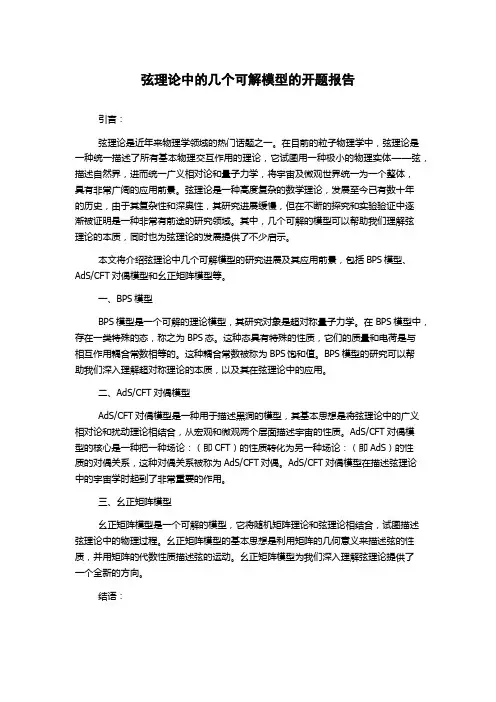
弦理论中的几个可解模型的开题报告引言:弦理论是近年来物理学领域的热门话题之一。
在目前的粒子物理学中,弦理论是一种统一描述了所有基本物理交互作用的理论,它试图用一种极小的物理实体——弦,描述自然界,进而统一广义相对论和量子力学,将宇宙及微观世界统一为一个整体,具有非常广阔的应用前景。
弦理论是一种高度复杂的数学理论,发展至今已有数十年的历史,由于其复杂性和深奥性,其研究进展缓慢,但在不断的探究和实验验证中逐渐被证明是一种非常有前途的研究领域。
其中,几个可解的模型可以帮助我们理解弦理论的本质,同时也为弦理论的发展提供了不少启示。
本文将介绍弦理论中几个可解模型的研究进展及其应用前景,包括BPS模型、AdS/CFT对偶模型和幺正矩阵模型等。
一、BPS模型BPS模型是一个可解的理论模型,其研究对象是超对称量子力学。
在BPS模型中,存在一类特殊的态,称之为BPS态。
这种态具有特殊的性质,它们的质量和电荷是与相互作用耦合常数相等的。
这种耦合常数被称为BPS饱和值。
BPS模型的研究可以帮助我们深入理解超对称理论的本质,以及其在弦理论中的应用。
二、AdS/CFT对偶模型AdS/CFT对偶模型是一种用于描述黑洞的模型,其基本思想是将弦理论中的广义相对论和扰动理论相结合,从宏观和微观两个层面描述宇宙的性质。
AdS/CFT对偶模型的核心是一种把一种场论:(即CFT)的性质转化为另一种场论:(即AdS)的性质的对偶关系,这种对偶关系被称为AdS/CFT对偶。
AdS/CFT对偶模型在描述弦理论中的宇宙学时起到了非常重要的作用。
三、幺正矩阵模型幺正矩阵模型是一个可解的模型,它将随机矩阵理论和弦理论相结合,试图描述弦理论中的物理过程。
幺正矩阵模型的基本思想是利用矩阵的几何意义来描述弦的性质,并用矩阵的代数性质描述弦的运动。
幺正矩阵模型为我们深入理解弦理论提供了一个全新的方向。
结语:弦理论是当前物理学领域中最热门的领域之一,它试图用数学工具来描述自然界的本质规律。
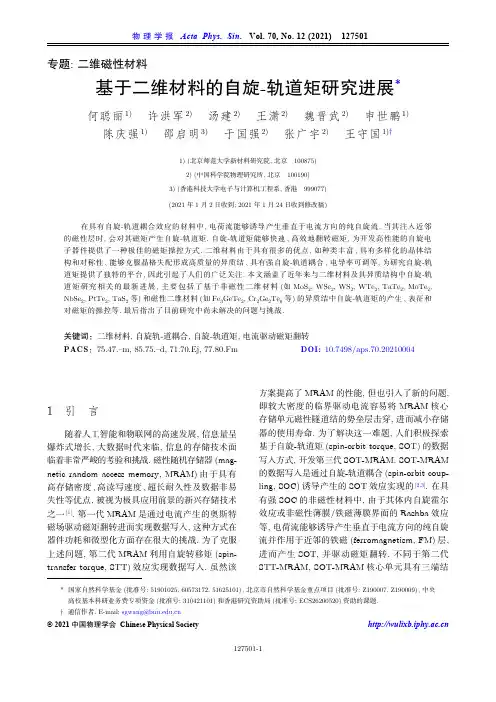
专题: 二维磁性材料基于二维材料的自旋-轨道矩研究进展*何聪丽1) 许洪军2) 汤建2) 王潇2) 魏晋武2) 申世鹏1)陈庆强1) 邵启明3) 于国强2) 张广宇2) 王守国1)†1) (北京师范大学新材料研究院, 北京 100875)2) (中国科学院物理研究所, 北京 100190)3) (香港科技大学电子与计算机工程系, 香港 999077)(2021 年1 月2日收到; 2021 年1 月24日收到修改稿)在具有自旋-轨道耦合效应的材料中, 电荷流能够诱导产生垂直于电流方向的纯自旋流, 当其注入近邻的磁性层时, 会对其磁矩产生自旋-轨道矩. 自旋-轨道矩能够快速、高效地翻转磁矩, 为开发高性能的自旋电子器件提供了一种极佳的磁矩操控方式. 二维材料由于具有很多的优点, 如种类丰富、具有多样化的晶体结构和对称性、能够克服晶格失配形成高质量的异质结、具有强自旋-轨道耦合、电导率可调等, 为研究自旋-轨道矩提供了独特的平台, 因此引起了人们的广泛关注. 本文涵盖了近年来与二维材料及其异质结构中自旋-轨道矩研究相关的最新进展, 主要包括了基于非磁性二维材料(如MoS2, WSe2, WS2, WTe2, TaTe2, MoTe2, NbSe2, PtTe2, TaS2等)和磁性二维材料(如Fe3GeTe2, Cr2Ge2Te6等)的异质结中自旋-轨道矩的产生、表征和对磁矩的操控等. 最后指出了目前研究中尚未解决的问题与挑战.关键词:二维材料, 自旋轨-道耦合, 自旋-轨道矩, 电流驱动磁矩翻转PACS:75.47.–m, 85.75.–d, 71.70.Ej, 77.80.Fm DOI: 10.7498/aps.70.202100041 引 言随着人工智能和物联网的高速发展, 信息量呈爆炸式增长, 大数据时代来临, 信息的存储技术面临着非常严峻的考验和挑战. 磁性随机存储器(mag-netic random access memory, MRAM)由于具有高存储密度、高读写速度、超长耐久性及数据非易失性等优点, 被视为极具应用前景的新兴存储技术之一[1]. 第一代MRAM是通过电流产生的奥斯特磁场驱动磁矩翻转进而实现数据写入, 这种方式在器件功耗和微型化方面存在很大的挑战. 为了克服上述问题, 第二代MRAM利用自旋转移矩(spin-transfer torque, STT)效应实现数据写入. 虽然该方案提高了MRAM的性能, 但也引入了新的问题,即较大密度的临界驱动电流容易将MRAM核心存储单元磁性隧道结的势垒层击穿, 进而减小存储器的使用寿命. 为了解决这一难题, 人们积极探索基于自旋-轨道矩(spin-orbit torque, SOT)的数据写入方式, 开发第三代SOT-MRAM. SOT-MRAM 的数据写入是通过自旋-轨道耦合(spin-orbit coup-ling, SOC)诱导产生的SOT效应实现的[2,3]. 在具有强SOC的非磁性材料中, 由于其体内自旋霍尔效应或非磁性薄膜/铁磁薄膜界面的Rashba效应等, 电荷流能够诱导产生垂直于电流方向的纯自旋流并作用于近邻的铁磁(ferromagnetism, FM)层,进而产生SOT, 并驱动磁矩翻转. 不同于第二代STT-MRAM, SOT-MRAM核心单元具有三端结* 国家自然科学基金(批准号: 51901025, 60573172, 51625101)、北京市自然科学基金重点项目(批准号: Z190007, Z190009)、中央高校基本科研业务费专项资金(批准号: 310421101)和香港研究资助局(批准号: ECS26200520)资助的课题.† 通信作者. E-mail: sgwang@© 2021 中国物理学会 Chinese Physical Society 构, 读写路径分开, 写入电流只需要经过磁性隧道结底部电极而不穿过超薄氧化物绝缘势垒层, 保护了势垒层不被击穿, 极大地延长了器件的寿命. 此外, 利用SOT操控磁矩可以实现比STT方案更快地写入速度及更低的功耗, 因此在低功耗、高速度非易失性存储和逻辑等领域具有广泛的应用前景.近年来, 利用SOT驱动磁矩翻转的相关研究备受关注[4−27], 并且研究内容不断扩展到很多研究方向, 包括磁畴壁运动、磁斯格明子运动、自旋逻辑器件、反铁磁磁矩操控、自旋神经形态器件及铁磁共振等[28−47]. 目前, 相关研究中用于产生SOT 的材料主要集中于重金属, 如Pt, Ta, W等. 通过开发新材料、发现新物理以提高SOT器件的各方面的性能是相关研究的重要目标. 受层状拓扑绝缘体(如Bi2Se3等)在SOT方面研究进展的影响, 基于二维材料的SOT器件研究逐渐引起了人们的关注[48−52]. 新兴的二维晶体和拓扑材料由于具有众多的优点, 如种类丰富、具有多样化的晶体结构和对称性、能够克服晶格失配形成高质量的异质结、具有强自旋-轨道耦合、电导率可调等, 为自旋电子学研究提供了理想的物理研究平台[52−57]. 例如, 二维过渡金属硫族化物(transition-metal dichalco-genides, TMDs)材料WTe2具有低对称性结构和强的SOC, 除了能够产生传统的自旋取向沿面内的自旋流外, 还可以产生自旋取向沿面外的自旋流, 进而诱导产生非传统的SOT, 理论上可以在无外磁场辅助的条件下直接翻转垂直磁矩[58]. 因此,探索二维材料异质结中的SOT、电流驱动磁矩翻转及相关自旋电子器件有非常重要的意义.本文首先总结了非磁性二维材料异质结中SOT效应研究的最新实验进展; 然后介绍了磁性二维材料异质结中SOT的表征和驱动磁矩翻转相关的工作; 最后, 简单地讨论一下未来将二维材料用于自旋电子器件所面临的问题和挑战, 并进行了总结和展望.2 基于非磁性TMD材料的异质结中SOT及电流驱动磁矩翻转有关二维材料SOT的研究最早是从非磁性TMD材料开始的. TMD材料的化学式为MX2, 其中M是过渡金属(如Mo, W, Ta, Pt, Nb等), X 是硫族元素(如S, Se, Te等). 这类材料家族包含σS,σAσB,σT了半导体材料(2H-MoS2, 2H-WSe2, WS2)和(半)金属性材料(WTe2, 1T-TaTe2, 1T′-MoTe2, NbSe2, PtTe2和TaS2等)[59−69]. 早期关于非磁性TMD 材料中SOT的研究集中于TMD/FM薄膜异质结的制备和SOT的表征, 其中的TMD材料主要选择了结构对称性相对较高的半导体材料, 如MoS2, WSe2, WS2等. 少数原子层厚度的TMD材料通过机械剥离或化学气相沉积(chemical vapor depo-sition, CVD); 铁磁材料可以通过磁控溅射或电子束蒸发等方式获得. 器件中电流产生的SOT的分量与效率通常可以通过自旋转矩铁磁共振(ST-FMR)、二次谐波霍尔等测量技术来表征. 随后, 人们很快将研究拓展到具有(半)金属特性的TMD 材料, 例如WTe2, TaTe2, MoTe2, WTe2, NbSe2, PtTe2等. 在研究这些材料的过程中, 人们首先意识到结构对称破缺对于SOT的重要性, 并发现了一种与对称破缺相关的平面外的新型类阻尼SOT.除了重要的物理发现外, 人们还利用(半)金属特性TMD材料中的强SOC和高导电性, 实现了电流高效驱动磁矩翻转. 此外, 人们也在开发大面积低维材料制备方法方面取得了重要的进展. 表1概述了目前已报道的非磁性TMD薄膜的晶体结构、制备方法、TMD/FM异质结中SOT的表征方法以及实验得到的TMD材料的自旋霍尔电导. 其中分别代表与面内类阻尼SOT、类场SOT相关的自旋霍尔电导; 分别代表与面外类阻尼SOT、面外类场SOT相关的自旋霍尔电导. SHH 代表二次谐波霍尔测量方法, ST-FMR代表自旋转矩铁磁共振测量方法. 与目前研究较多的传统重金属SOT材料相比(其类阻尼SOT效率通常在0.1—0.3之间), 非磁性TMD材料不仅展示了较大的SOT效率, 还展现出了一些独特的优势, 如产生新型类阻尼SOT、电场可调等特性, 有望为自旋电子器件引入许多特殊的性能. 下文将针对不同材料中SOT的研究展开具体的介绍.2.1 二维半导体材料(τDL)τFL2H-MoS2是一种二维半导体材料, 因具有宽能隙和高迁移率等特性而备受关注. 它具有六角晶格结构, 每个Mo原子与6个最近邻S原子结合,属于P6/mmc空间群. 单层MoS2与FM层接触时, 由于界面对称性的破缺, 电流能够诱导产生类阻尼SOT和类场SOT()两种效应. ZhangR 2ωH(φ)ℏ/(2e )ℏ/(2e )等[59]最早通过ST-FMR 技术研究了MoS 2/Ni 80Fe 20(Py)异质结中的SOT. 其中MoS 2是通过CVD 方法制备的单层三角形晶粒. 如图1(a)和图1(b)所示, 其对称峰值(与类阻尼SOT 相关)约为反对称峰值(与类场SOT 相关)的4倍, 表明类阻尼SOT 可能比类场SOT 大得多. 由于逆Rashba-Edelstein 效应诱导的自旋泵浦可能也有很大的贡献, 该工作没有量化SOT 的强度. Shao 等[60]进一步通过二次谐波霍尔方法定量研究了MoS 2(WSe 2)/CoFeB 异质结中电流产生的SOT. 其中, MoS 2是CVD 方法生长的大面积单层薄膜. 如图1(c)所示. 测量得到的二次谐波霍尔电阻 的典型方位角依赖性如图1(d)所示. 通过分析二次谐波霍尔电阻对方位角(j )依赖性的不同, 可以分离得到类阻尼SOT 和类场SOT 的大小. 实验结果表明, MoS 2,WSe 2的类场SOT 对应的自旋电导分别为2.9 ×103 (W ·m)–1, 5.5 × 103 (W ·m)–1; 类阻尼SOT 在实验测试误差范围内为零. Shao 等[60]认为, 实验到观察到的类场SOT 主要归因于界面Rashba-Edelstein 效应. 当前, 大多数的SOT 器件采用外场辅助下类阻尼SOT 驱动垂直磁矩翻转的操控机制, 因此获得大的类阻尼SOT 是人们所期望的. 虽然上述工作表明CVD 生长的单层MoS 2和WSe 2可能无法产生人们所需要的较大的类阻尼SOT, 但较大的类场SOT 的发现让人们看到了利用TMD 材料产生SOT 的信心, 因此激发了更多的科研人员开展TMD 材料中SOT 的相关研究.Lv 等[61]采用ST-FMR 技术研究了1L-WS 2/Py(10 nm)异质结构中的SOT (图1(e)). 样品中WS 2和Py 薄膜分别通过CVD 方法和电子束蒸发τFL /τDL 方法制备. 实验观察到了类阻尼SOT 和类场SOT,其主要物理起源被归因于界面Rashba-Edelstein 效应. 这个实验再次证明了利用单层TMD 材料能够产生SOT. 更重要的是, Lv 等[61]还证明栅压可以调控TMD 材料所产生的SOT (图1(f)). 当施加栅压从–60 V 到60 V, 从0.05增大到0.22. 他们认为, 栅压可调的特性可能源于载流子密度的改变导致的WS 2/Py 界面电流的变化. 对于二维材料来说, 特别是对于具有半导体特性的单层二维材料, 栅压调控属性将是它较传统金属材料的一个重要优势, 有望在电场辅助存储和逻辑器件应用中发挥作用.2.2 二维(半)金属材料(3.6±0.8)×103ℏ/(2e )(Ω·m )−1除了半导体TMD 材料之外, (半)金属TMD 材料也被广泛地研究. 研究这类材料的主要驱动力在于它们具有高导电性、强自旋-轨道耦合、低结构对称性等. 人们最早研究的(半)金属TMD 材料是WTe 2, 属于Pmn 21空间群. 同MoS 2相比, 它具有更低的对称性, 满足产生非传统SOT 的对称性要求. MacNeill 等[58]首次利用ST-FMR 技术研究了WTe 2/Py 异质结构中的SOT, 如图2(a)所示. 除了传统的类场SOT 和类阻尼SOT, 实验还观察到了非传统的面外SOT (图2(b)), 其对应的自旋霍尔电导为,且大小随着施加电流和WTe 2晶体a 轴的角度的增大而减小. 当施加电流和a 轴垂直, 即沿b 轴时,非传统SOT 消失, 这表明了非传统SOT 与晶体的对称性有关. 尽管早期的研究中显示SOT 对厚度的依赖关系很小, 随着更深入的研究及更宽的厚表 1 已报道的实验研究工作中TMD 材料的晶体结构、制备方法、TMD/FM 异质结中的SOT 的表征方法以及自旋霍尔电导Table 1. Crystal structure, preparation method, method for SOT measurement of the TMD/FM heterostructure, and spin Hall conductance of TMD materials in the previous studies.TMD 材料空间群制备方法表征方法/[103(ℏ/2e )自旋霍尔电导 (W ·m)–1]文献MoS 2P 6/mmc CVD SHH σA = 2.9[60]WSe 2P 6/mmc CVD SHH σA = 5.5[60]WS 2P 6/mmc CVD SHH σA ,σSobserved[61]WTe 2Pmn 21Exfoliation ST-FMR/SHH σA=σS =σB = 9 ± 3, 8 ± 2, 3.6 ± 0.8[58]WTe 2Pmn 21Exfoliation ST-FMR/SHH σA ,σS σB ,observed [62]TaTe 2C 2/m Exfoliation ST-FMR/SHH σA ,σS σB ,observed[64]MoTe 2P 21/m Exfoliation ST-FMR σS=4.4—8.0,σB =0.04—1.6,σT =0.026—1.0[65]NbSe 2P 63/mmcExfoliation ST-FMR σA=0—40,σS =0—13,σT =−2—3.5[66]PtTe 2—CVDST-FMR σS=0.20—1.6×102[68]TaS 2—Ion-beam sputteringST-FMR/SHHσS=14.9×102[69]度范围的研究, 传统和非传统SOT 都表现出了厚度的依懒性, 说明其微观起源除了界面效应还有体效应的贡献[62,67]. Shi 等[62]在WTe 2/Py 异质结构中实现了非常有效的电流驱动平面内磁矩翻转(图2(c)), 翻转电流密度约为2.96 × 105 A/cm 2. 更有趣的是, 在该体系中, 还观察到了Dzyaloshinskii-Moriya 相互作用, 为进一步研究手性磁结构提供了材料基础.1.0(b)0.50A n t i s y m m e t r i c a m p l i t u d e-0.5-1.0-1.5-2.0103050 /(O )7090(f)0.250.200.150.100.05-20-40-604020060g /VF L / D LPyWS 2/Py1.5(d)1.00.50-0.5-1.0-1.5120240/(O )360H a l l /m W2 Fit to u sin( )+//sin( )cos(2 )sin( ) termsin( )cos(2 ) termext =100 Oe ac _RMS =1 mA8(a)6420S y m m e t r i c a m p l i t u d e-2-4-6-8103050 /(O )7090CoFeB 2H+, L+ H- //m mextL- u(c)gWS 2Si/SiO 2PyRFu//(e)τFL /τDL 图 1 MoS 2/Py 异质结中ST-FMR 信号的对称(a)和反对称(b)振幅随外加磁场与平面夹角q 的依赖关系(插图为基于MoS 2/Py 异质结的ST-FMR 器件光学显微镜图)[59]; (c) MX 2/CoFeB 异质结的SOT 测量装置示意图; (d) 二次谐波方法测得二阶霍尔电阻与j 的函数关系, 外加磁场为100 Oe (1 Oe = 103/(4π) A/m)[60]; (e) WS 2/Py 双层器件几何结构示意图, 其中V g 通过SiO 2介质层施加; (f)V g 对Py 和WS2/Py 双层的转矩比 调控特性[61]τFL /τDL Fig. 1. Out-of-plane (OOP) angular (the applied field is described by the polar angle) dependence of symmetric (a) and antisymmet-ric (b) components of the ST-FMR signal based on MoS 2/Py heterostructure (the inset is photo image of ST-FMR device)[59];(c) measurement setup of SOT measurements for the MX 2/CoFeB bilayer; (d) second-harmonic Hall resistance as a function of j with an external magnetic field 100 Oe applied [60]; (e) schematic of the WS 2/Py bilayer device geometry, where V g was applied through the SiO 2 dielectric layer; (f) torque ratio dependence of V g for Py and WS 2/Py bilayer [61].P u l s e a m p l i t u d e1.58T 105/(A S cm -2)2.96T 1052.37T 105(c)1050A /m V-5-10WTe 2/Py, // -axis40200-20-40-90090180270S /m Vsin(2 -2 0)cos( - 0)(b)u//RFNi 80Fe 20(Py)6 nmWTe 2(a)108642002468TMD /nmK 3 e )S W -1S m -110121416S B(d)S 5 e )S W -1S m -1S O T2015PtTe 2/nmPtTe 2( )/Py(5)105(f) DLextCurrentPtTe 2CoTb Au(g)-30-20-100 dc /mA102030-1500 Oe-1000 Oe-500 Oe0 Oe +500 Oe10+1000 Oe+1500 OeH m W(h)(e)1.00.50-0.5-1.0E n e r g y /e Vσs 图 2 (a) WTe 2/Py 异质结样品几何结构示意图; (b) WTe 2/Py 器件的对称和反对称ST-FMR 信号与面内磁场角度的依赖关系,其中电流平行于a 轴[58]; (c) 由MOKE 图像捕捉到的电流驱动磁矩翻转过程[62]; (d) 自旋电导率随MoTe 2厚度的变化关系[65];(e) MoTe 2单斜1T ′相的晶体结构和20层MoTe 2薄膜的能带结构[70]; (f) PtTe 2/Py 器件ST-FMR 测量SOT 效率x SOT 和自旋霍尔电导率 的厚度依赖性; (g) PtTe 2/Au/CoTb 结构和PtTe 2中电流产生的SOT 的示意图; (h)在不同的面内磁场下, PtTe 2中电流产生的SOT 驱动具有垂直磁各向异性的CoTb 层磁矩翻转[68]Fig. 2. (a) Schematic of the bilayer WTe 2/Py sample geometry; (b) symmetric and antisymmetric ST-FMR resonance components for a WTe 2 (5.5 nm)/Py (6 nm) device as a function of in-plane magnetic-field angle, with current applied parallel to the a -axis [58];(c) switching process captured by MOKE images [62]; (d) spin conductivities as a function of the thickness of MoTe 2, where s S stands for the conventional damping-like torque, s B stands for the out-of-plane damping-like torque, and s T stands for the out-of-plane field-like torque [65]; (e) crystal structure of the monoclinic 1T ′ phase of MoTe 2 and band structure of a MoTe 2 slab with 20 monolay-ers [70]; (f) thickness dependence of x SOT and spin Hall conductivity s s of PtTe 2/Py measured by ST-FMR; (g) schematic layout for PtTe 2/Au/CoTb stack and the SOT generated by the majority of current flowing in PtTe 2; (h) current-induced switching of the CoTb layer by SOT from PtTe 2 under different in-plane field [68].因为低对称性是允许产生非传统面外SOT的前提条件, 后续一些实验重点针对具有低对称性的TMD材料展开. MoTe2属于P21/m空间群, 满足产生面外t DL的对称性要求. Stiehl等[65]采用ST-FMR技术研究了b相MoTe2/Py体系中的SOT, 传统的和非传统的SOT同时被观察到. 实验发现, 除了原因尚不清楚的2层MoTe2外, 面内和面外SOT对应的自旋电导都没有明显的厚度依赖性(图2(d)), 揭示了MoTe2/Py体系中SOT的界面起源. Liang等[70]同样研究了1T′-MoTe2/ Py异质结中的SOT, 但并未发现面外SOT, 暗示了面外SOT起源的复杂性. 该实验重点集中于室温零磁场下的电流驱动磁矩翻转, 翻转电流比传统重金属材料(例如Pt)要小一个数量级. 实验还研究了该体系中的SOT效率. 对于其研究的最薄厚度为66.1 nm的MoTe2器件, 其SOT效率(x SOT)约为0.35, 比Ta (~0.15), Pt (~0.06)都要大很多. 翻转电流随MoTe2厚度的增大而增大, SOT 效率呈现了随着MoTe2厚度增大而降低. 能带结构计算结果(图2(e))表明, 除了考虑体自旋霍尔效应外, 还需要考虑界面Rashba-Edlstein的贡献.此外, 他们还设计了哑铃形的异质结磁性器件, 翻转电流进一步降低了60%之多. 这些发现展示了MoTe2等半金属二维材料在低功耗自旋电子器件领域的应用前景.上面两个关于MoTe2的实验对比说明了非传统面外SOT的起因可能是比较复杂的, 这个结论进一步被TaTe2和NbSe2的实验研究所印证[64]. TaTe2属于C2/m空间群, 同样满足非传统SOT 对称性的要求. 但Stiehl等[65]在TaTe2/Py异质结构中并未发现面外SOT, 只观察到了具有Dress-elhaus对称性的SOT. 该SOT起源于TaTe2中各向异性的电导率导致的面内横向电流分量产生的奥斯特场. 在WTe2/Py双层膜中也有类似的影响.除了常规奥斯特转矩和Dresselhaus型转矩外, 并未观察到非传统的SOT, 这可能是由于TaTe2中SOC较弱. 同时Stiehl等[65]也论证了低对称性晶体中面内的各向异性电导率对体系中SOT的重要影响. Guimaraes等[66]采用ST-FMR研究了NbSe2/ Py双层膜中电流诱导的SOT. NbSe2具有属于P63/mmc空间群的六边形结构, 与MoS2类似, 其对称性是禁止产生非传统SOT的. 然而, 除了预期的SOT分量外, 他们依然观察到了非传统的SOT. Guimaraes等[66]将产生的非传统SOT归因于器件加工过程中引起的应变效应, 这种应变效应破坏了旋转对称性, 允许产生非传统SOT. 该结果表明除了晶格结构对称性之外, 与界面质量、局部原子点群对称性相关的其他微观因素也可能对诱导产生非传统SOT起到重要作用.(0.2—1.6)×105ℏ/(2e)(Ω·m)−1上面提到的实验主要集中于探索非传统面外SOT、开发具有大自旋霍尔角且高导电性的TMD 材料. 这些研究主要基于机械剥离的实验方案, 该方法制备样品的产率较低. 如何制备具有大自旋霍尔角且高导电性的大面积TMD材料, 也是将TMD材料用于器件的关键. 最近, Xu等[68]成功制备了大面积、高质量、厚度可控的PtTe2薄膜并且首次研究了这种第二类狄拉克半金属的SOT效应. 该PtTe2薄膜在室温下具有高导电性(约为106 S/m). 因为PtTe2在大气环境中相对稳定, 均匀、平整、大面积的PtTe2薄膜可转移到磁控溅射设备中制备自旋电子器件. 通过对PtTe2/Py异质结进行系统性的ST-FMR测量发现PtTe2薄膜具有较大的类阻尼SOT: 忽略界面自旋的损失, 5 nm 厚的PtTe2的自旋霍尔角在0.09—0.15范围, 是对照实验中4 nm厚Pt的1.5—2倍. 从PtTe2中SOT效率随厚度非单调变化的实验结果(图2(f))可以推测PtTe2产生的SOT具有块体态与表面态两个不同的来源. 由于PtTe2的高导电性以及较大的自旋霍尔角, 可实现非常高的自旋霍尔电导率,达, 能与典型的拓扑绝缘体Bi2Se3相比拟. 进一步的垂直磁矩翻转实验也证实了PtTe2具有比Pt更高的电荷-自旋转换效率(图2(g)和图2(h)). 该研究表明PtTe2以及狄拉克半金属有希望应用于低功耗SOT器件及其他自旋电子学器件中, 同时该工作也揭示了大规模制备PtTe2类似的二维拓扑材料的可能性.ℏ/(2e)(Ω·m)−1除了上述方法外, Husain等[69]采用离子束溅射的方法制备了大面积单层TaS2材料, 并采用ST-FMR和二次谐波霍尔测量手段, 研究了TaS2/ Py异质结构中的SOT. 在这种异质结构中, 观察到了相当大的类场SOT和类阻尼SOT. 其中, 自旋霍尔角为0.25 ± 0.03, 自旋霍尔电导率14.9 ×105 , 是目前报道的TMD材料中的最大值. 研究发现, 大的类阻尼SOT来源于TaS2/Py异质结构的界面特性, 该发现得到了密度泛函理论计算结果的支持. 界面自旋-轨道-耦合与晶体对称性之间的相互作用会产生大的类阻尼SOT. 该工作为设计下一代基于TMD 材料的低功耗量子存储器件提供了有效的思路.3 基于磁性二维材料异质结构中的SOT 及电流驱动磁矩翻转非磁性二维材料由于可以产生SOT, 能够用于代替SOT 器件中的重金属材料. 另一方面, 最新发现磁性二维材料(如CrI 3, Cr 2Ge 2Te 6 (CGT),Fe 3GeTe 2 (FGT)等[71−76])同样可以应用于自旋电子器件中. 磁性二维材料具有许多独特而优异的性能. 例如, 磁性二维材料优良的栅极可调性为探索磁电耦合现象和应用提供了条件[73,77]. 层状反铁磁二维材料如CrI 3显示出高达19000%的隧穿磁电阻[78], 展现了磁性二维材料的巨大优势. 利用二维铁磁金属FGT 还可以构建无间隔层的自旋阀及全二维垂直自旋阀[79,80], 揭示了利用二维磁性同质或者异质结实现多态非易失磁存储和逻辑的可能性.此外, 二维铁磁材料中发现的磁斯格明子[81−87],也展现了其用于高密度赛道存储器件的可能性. 从上述相关工作能够看出, 范德瓦耳斯(van der Waals, vdW)异质结构在开发新型自旋电子器件方面的潜在机会, 磁性二维vdW 材料为新型自旋器件的开发提供了一个平台, 对于开发新型自旋电子器件具有重要的研究价值.将vdW 材料用于构建自旋电子器件关键的挑战在于如何有效地操控其磁矩, 实现从一种状态到另一种状态的转换. 国内外两个研究团队几乎同时报道了FGT/Pt 异质结中的高效SOT 及电流驱动翻转方面的重要进展(图3(a)—(c))[88,89]. 当电流在重金属Pt 中流动时, 会产生自旋电流并注入磁性FGT 中, 利用该自旋流可以有效地操控少层磁体FGT 的磁矩方向. 图3(b)展示了FGT 在面内磁场分别为H x = 50和–50 mT 的辅助下, 温度为100 K 时的电流驱动磁化翻转. FGT 的磁化通PtPtTe Ge Fe 3GeTe 2eFe(a)-0.14/W/mA0 =50 mT100 K0.14-0.14/W/mA0 =-50 mT0.14(b)F GT P tDL 6420246/kOe810-0.500.51.0-1.0/(1011 A S m -2)0(c)write_read/W/kOe''0'' state''1'' state(mA)0.051.5(d)-(d c m A(mT))150100500-50-100-20-101020-150(e)WTeFeGeFGTWTe 20.90.60.30-0.3A H /W-0.6-1.5-1.0-0.50/kOe0.51.0K FGT(12.7)/WTe 2(9.4)1.5/(104 A S cm -2)(f)图 3 FGT/Pt 双层器件的示意图(a)和SOT 驱动的垂直磁矩翻转(b)[88]; (c) SOT 驱动FGT 磁矩翻转有效翻转电流随施加面内磁场的变化[89]; (d) 基于FGT 的磁存储器件原理图及电流诱导的矫顽场大幅度降低, 从而降低写入电流密度[90]; (e) 基于CGT/Ta 异质结Hall 器件的原理图和4 K 温度下施加流过Ta 的电流I dc 和平面内磁场H x 组合时的磁矩m z 相图[91]; (f) FGT/WTe 2双层结构的原子示意图和不同电流密度下FGT/WTe 2 霍尔条在10 K 垂直磁场下的反常霍尔电阻[92]Fig. 3. Schematic view (a) and SOT-driven perpendicular magnetization switching (b) in the FGT/Pt bilayer device [88]; (c) current-induced magnetization switching of FGT and effective switching current as a function of applied in-plane magnetic field [89];(d) schematic of FGT-based magnetic memory device and the current-induced substantial reduction of the coercive field and then reduction of the write current [90]; (e) schematic of a fabricated Hall bar device from a CGT/Ta heterostructure and phase diagram of m z for applied combinations of I dc and H x at 4 K [91]; (f) atomic schematic view of FGT/WTe 2 bilayer structure and anomalous Hall resistance of the FGT/WTe 2 Hall bar under a perpendicular magnetic field at 10 K with various current densities [93].过电流扫描从一种状态切换到另一种状态. 正(负)面内磁场的翻转极性为逆时针(顺时针), 表明Pt的自旋霍尔角为正, 与之前报道的研究工作一致. 值得注意的是, SOT操控所实现的两个电阻状态并不是完全饱和的(饱和态由图3(b)中虚线表示), 该现象被归因于电流导致的热效应. 研究人员还利用谐波测量进一步定量表征了SOT有效磁场, 并以此为依据估算了少层FGT的饱和磁化强度的上限, 该值比块体材料的饱和磁化强度小一个量级. 除Pt诱导产生SOT外, 最近的研究表明电流在每一个单层的FGT中也会产生局域SOT[90],并能够对FGT的矫顽场产生有效的调制(图3(d)).同时利用重金属中产生的SOT和FGT中的局域SOT, 将有利于进一步降低翻转FGT磁矩的电流密度. 上述有关电流操控FGT磁矩所取得的进展进一步推动探索更多vdW磁性材料在自旋电子学器件中的应用.近期, Ostwal等[91]和Gupta等[92]分别进行了通过SOT对vdW铁磁体CGT中磁矩调控的研究. Ostwal等[91]在CGT/Ta异质结构中(图3(e)),施加平面内磁场和流过Ta (一种表现出巨大自旋霍尔效应的重金属)的电流组合, 在面内磁场为20 mT时, 用低至5 × 105 A/cm2的电荷电流密度实现了CGT的磁矩翻转. 该电流密度比翻转非层状金属铁磁体CoFeB等所需的电流密度低两个数量级. 这些结果显示了二维磁性材料未来应用于自旋电子器件的巨大潜力.到目前为止, 大多数的工作主要集中于范德瓦耳斯材料与传统的金属材料构成的异质结中的SOT研究. 未来, 探索利用全二维材料SOT器件将成为一个重要的研究方向. Shao等[93]已经进行了初步的尝试, 研究了FGT/WTe2双层vdW异质结构中的反常霍尔效应(图3(f)). 在这种器件中, 电流可以有效地调节FGT薄片的矫顽力, 主要归因于FGT/WTe2双层界面热导较低而产生焦耳热效应. 虽然该实验没有实现SOT驱动磁矩的翻转, 但阐明了选择热性能好的二维材料来提高界面热导是非常重要的, 为进一步实现具有性能优良的全二维自旋电子器件提供了思路.4 结论与展望本文综述了基于二维材料的SOT领域的最新研究进展, 重点介绍了基于TMD/FM异质结构中SOT的研究现状、基于磁性二维材料异质结构中的SOT及电流驱动磁矩翻转的研究进展. TMD 材料中SOT研究的广泛关注很大程度上得益于传统SOT材料的快速发展和器件应用的良好研究环境. 但与传统重金属材料中的SOT研究相比, 有关二维vdW材料及其异质结的SOT的研究刚刚兴起, 还主要处于材料探索和基础物理研究阶段.虽然研究还处于初期阶段, 但已经发现了很多新奇的物理现象, 如产生新型面外类阻尼SOT、电场可调等特性, 展现了良好的发展态势, 进一步的材料、物理和器件应用研究也呈现出不断扩大和深入的趋势. 基于当前的研究成果来看, 二维vdWs材料的器件应用进程依然存在着几个方面的挑战:1)二维材料中非传统SOT的微观物理机制仍不清楚. 目前实验所观测到的非传统SOT不能用我们所熟悉的自旋霍尔效应或界面Rashba-Edels-tein效应解释, 背后的物理机制仍有待探究. 进一步从理论上阐明非传统SOT的产生机制将有助于找到提高其强度的方法, 促进非传统SOT在操控垂直磁矩方面的应用. 值得指出的是, 利用二维材料谷霍尔效应[94−96]也有可能产生垂直极化的自旋流, 有望用于产生垂直SOT[97].2)磁性二维材料的居里温度需要进一步提高.虽然磁性二维材料在一些方面展现出了优势, 但目前大多数磁性二维材料的居里温度都在室温以下,极大地限制了其在自旋电子器件中的应用. 如何进一步提高居里温度是磁性二维材料相关的物理研究的重要方向, 也是其是否能够用于自旋电子器件的关键. 目前, 一些研究已经报道了相关的技术方案, 能够将已有的磁性二维材料的居里温度提高,如利用离子液体进行电场调控[73]、利用微结制备方式[98]、界面反铁磁诱导[99]、Ga离子注入[100]等方式. 此外, 不断探索更多的磁性低维材料也是寻求实现高居里温度的关键[101−103].3)晶圆级二维材料的制备. 虽然通过机械剥离制备的二维材料具有很高晶体质量, 但由于样品尺寸小, 无法实现大规模生产制备. 生长二维晶体材料的常用方法: 分子束外延、化学气相沉积、金属有机化学气相沉积和磁控溅射. 在晶圆尺度上确保二维材料的单晶度和均匀性是至关重要的. 最近的一些研究进展为解决这个问题提供了一些思路.例如, Zhang课题组[104−106]一直致力于采用CVD 方法实现TMD二维材料的高质量晶圆级生长;。
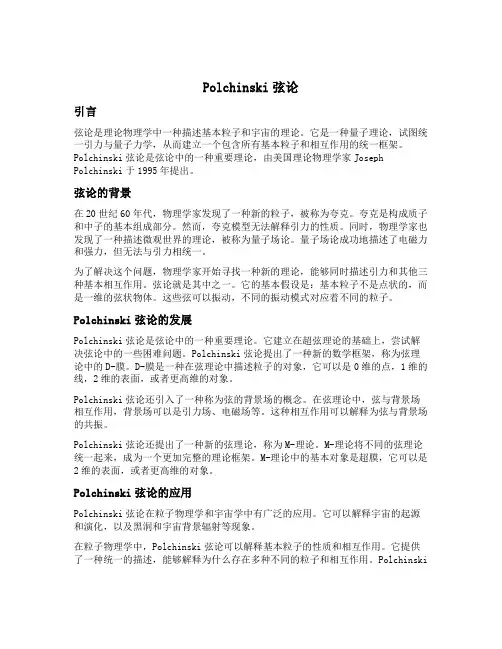
Polchinski弦论引言弦论是理论物理学中一种描述基本粒子和宇宙的理论。
它是一种量子理论,试图统一引力与量子力学,从而建立一个包含所有基本粒子和相互作用的统一框架。
Polchinski弦论是弦论中的一种重要理论,由美国理论物理学家Joseph Polchinski于1995年提出。
弦论的背景在20世纪60年代,物理学家发现了一种新的粒子,被称为夸克。
夸克是构成质子和中子的基本组成部分。
然而,夸克模型无法解释引力的性质。
同时,物理学家也发现了一种描述微观世界的理论,被称为量子场论。
量子场论成功地描述了电磁力和强力,但无法与引力相统一。
为了解决这个问题,物理学家开始寻找一种新的理论,能够同时描述引力和其他三种基本相互作用。
弦论就是其中之一。
它的基本假设是:基本粒子不是点状的,而是一维的弦状物体。
这些弦可以振动,不同的振动模式对应着不同的粒子。
Polchinski弦论的发展Polchinski弦论是弦论中的一种重要理论。
它建立在超弦理论的基础上,尝试解决弦论中的一些困难问题。
Polchinski弦论提出了一种新的数学框架,称为弦理论中的D-膜。
D-膜是一种在弦理论中描述粒子的对象,它可以是0维的点,1维的线,2维的表面,或者更高维的对象。
Polchinski弦论还引入了一种称为弦的背景场的概念。
在弦理论中,弦与背景场相互作用,背景场可以是引力场、电磁场等。
这种相互作用可以解释为弦与背景场的共振。
Polchinski弦论还提出了一种新的弦理论,称为M-理论。
M-理论将不同的弦理论统一起来,成为一个更加完整的理论框架。
M-理论中的基本对象是超膜,它可以是2维的表面,或者更高维的对象。
Polchinski弦论的应用Polchinski弦论在粒子物理学和宇宙学中有广泛的应用。
它可以解释宇宙的起源和演化,以及黑洞和宇宙背景辐射等现象。
在粒子物理学中,Polchinski弦论可以解释基本粒子的性质和相互作用。
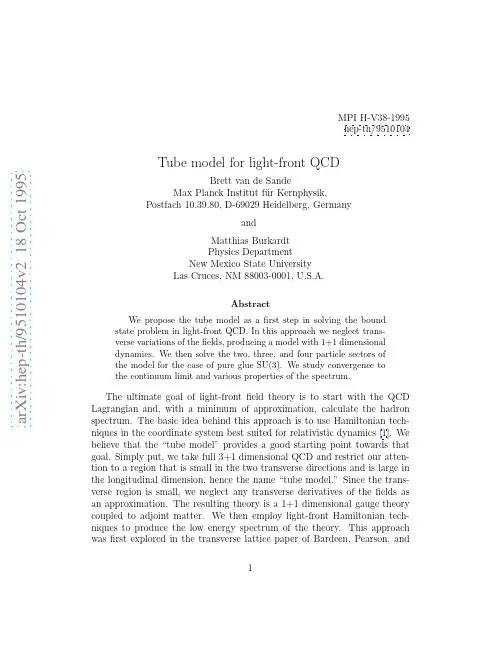
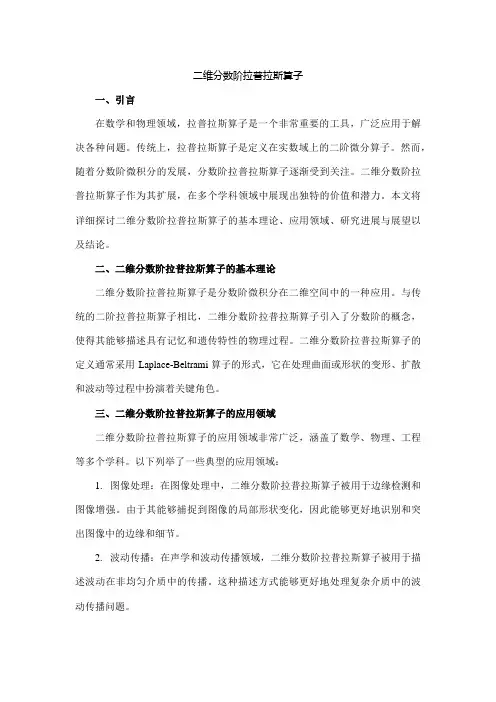
二维分数阶拉普拉斯算子一、引言在数学和物理领域,拉普拉斯算子是一个非常重要的工具,广泛应用于解决各种问题。
传统上,拉普拉斯算子是定义在实数域上的二阶微分算子。
然而,随着分数阶微积分的发展,分数阶拉普拉斯算子逐渐受到关注。
二维分数阶拉普拉斯算子作为其扩展,在多个学科领域中展现出独特的价值和潜力。
本文将详细探讨二维分数阶拉普拉斯算子的基本理论、应用领域、研究进展与展望以及结论。
二、二维分数阶拉普拉斯算子的基本理论二维分数阶拉普拉斯算子是分数阶微积分在二维空间中的一种应用。
与传统的二阶拉普拉斯算子相比,二维分数阶拉普拉斯算子引入了分数阶的概念,使得其能够描述具有记忆和遗传特性的物理过程。
二维分数阶拉普拉斯算子的定义通常采用Laplace-Beltrami算子的形式,它在处理曲面或形状的变形、扩散和波动等过程中扮演着关键角色。
三、二维分数阶拉普拉斯算子的应用领域二维分数阶拉普拉斯算子的应用领域非常广泛,涵盖了数学、物理、工程等多个学科。
以下列举了一些典型的应用领域:1.图像处理:在图像处理中,二维分数阶拉普拉斯算子被用于边缘检测和图像增强。
由于其能够捕捉到图像的局部形状变化,因此能够更好地识别和突出图像中的边缘和细节。
2.波动传播:在声学和波动传播领域,二维分数阶拉普拉斯算子被用于描述波动在非均匀介质中的传播。
这种描述方式能够更好地处理复杂介质中的波动传播问题。
3.流体动力学:在流体动力学中,二维分数阶拉普拉斯算子被用于描述流体在弯曲界面上的流动行为。
这种描述方式能够更好地处理流体的界面效应和粘性流动问题。
4.生物医学工程:在生物医学工程中,二维分数阶拉普拉斯算子被用于描述生物组织的变形和扩散过程。
这种描述方式能够更好地处理生物组织的非线性和非局部行为。
5.机器学习与数据科学:在机器学习和数据科学中,二维分数阶拉普拉斯算子被用于特征提取和数据降维。
通过利用其局部形状变化性质,可以更好地处理高维数据并提取有意义特征。
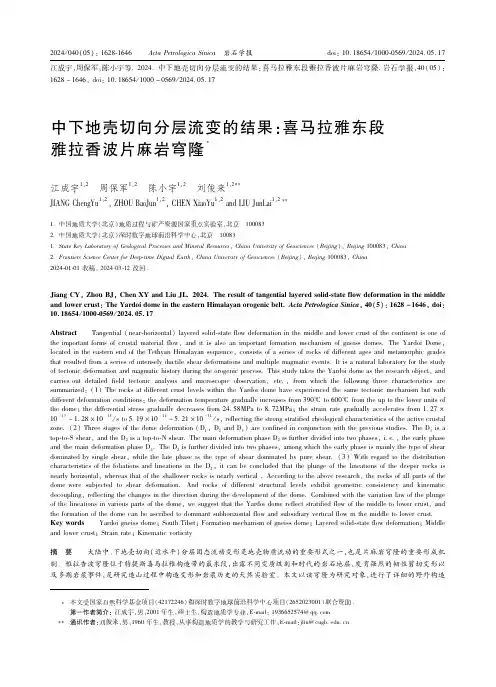
2024/040(05):1628 1646ActaPetrologicaSinica 岩石学报doi:10.18654/1000 0569/2024.05.17江成宇,周保军,陈小宇等.2024.中下地壳切向分层流变的结果:喜马拉雅东段雅拉香波片麻岩穹隆.岩石学报,40(05):1628-1646,doi:10.18654/1000-0569/2024.05.17中下地壳切向分层流变的结果:喜马拉雅东段雅拉香波片麻岩穹隆江成宇1,2 周保军1,2 陈小宇1,2 刘俊来1,2JIANGChengYu1,2,ZHOUBaoJun1,2,CHENXiaoYu1,2andLIUJunLai1,2 1 中国地质大学(北京)地质过程与矿产资源国家重点实验室,北京 1000832 中国地质大学(北京)深时数字地球前沿科学中心,北京 100831 StateKeyLaboratoryofGeologicalProcessesandMineralResources,ChinaUniversityofGeosciences(Beijing),Beijing100083,China2 FrontiersScienceCenterforDeep timeDigitalEarth,ChinaUniversityofGeosciences(Beijing),Beijing100083,China2024 01 01收稿,2024 03 12改回JiangCY,ZhouBJ,ChenXYandLiuJL 2024 Theresultoftangentiallayeredsolid stateflowdeformationinthemiddleandlowercrust:TheYardoidomeintheeasternHimalayanorogenicbelt.ActaPetrologicaSinica,40(5):1628-1646,doi:10.18654/1000 0569/2024.05.17Abstract Tangential(near horizontal)layeredsolid stateflowdeformationinthemiddleandlowercrustofthecontinentisoneoftheimportantformsofcrustalmaterialflow,anditisalsoanimportantformationmechanismofgneissdomes TheYardoiDome,locatedintheeasternendoftheTethyanHimalayansequence,consistsofaseriesofrocksofdifferentagesandmetamorphicgradesthatresultedfromaseriesofintenselyductilesheardeformationsandmultiplemagmaticevents Itisanaturallaboratoryforthestudyoftectonicdeformationandmagmatichistoryduringtheorogenicprocess ThisstudytakestheYardoidomeastheresearchobject,andcarriesoutdetailedfieldtectonicanalysisandmicroscopicobservation,etc ,fromwhichthefollowingthreecharacteristicsaresummarized:(1)TherocksatdifferentcrustlevelswithintheYardoidomehaveexperiencedthesametectonicmechanismbutwithdifferentdeformationconditions:thedeformationtemperaturegraduallyincreasesfrom390℃to600℃fromtheuptothelowerunitsofthedome;thedifferentialstressgraduallydecreasesfrom24 58MPato8 72MPa;thestrainrategraduallyacceleratesfrom1 27×10-13~1 28×10-13/sto5 19×10-11~5 21×10-11/s,reflectingthestrongstratifiedrheologicalcharacteristicsoftheactivecrustalzone (2)Threestagesofthedomedeformation(D1,D2andD3)areconfinedinconjunctionwiththepreviousstudies TheD1isatop to Sshear,andtheD2isatop to Nshear ThemaindeformationphaseD2isfurtherdividedintotwophases,i e ,theearlyphaseandthemaindeformationphaseD2 TheD2isfurtherdividedintotwophases,amongwhichtheearlyphaseismainlythetypeofsheardominatedbysingleshear,whilethelatephaseisthetypeofsheardominatedbypureshear (3)WithregardtothedistributioncharacteristicsofthefoliationsandlineationsintheD2,itcanbeconcludedthattheplungeofthelineationsofthedeeperrocksisnearlyhorizontal,whereasthatoftheshallowerrocksisnearlyvertical.Accordingtotheaboveresearch,therocksofallpartsofthedomeweresubjectedtosheardeformation Androcksofdifferentstructurallevelsexhibitgeometricconsistencyandkinematicdecoupling,reflectingthechangesinthedirectionduringthedevelopmentofthedome Combinedwiththevariationlawoftheplungeofthelineationsinvariouspartsofthedome,wesuggestthattheYardoidomereflectstratifiedflowofthemiddletolowercrust,andtheformationofthedomecanbeascribedtodominantsubhorizontalflowandsubsidiaryverticalflowinthemiddletolowercrust Keywords Yardoigneissdome;SouthTibet;Formationmechanismofgneissdome;Layeredsolid stateflowdeformation;Middleandlowercrust;Strainrate;Kinematicvorticity摘 要 大陆中、下地壳切向(近水平)分层固态流动变形是地壳物质流动的重要形式之一,也是片麻岩穹隆的重要形成机制。
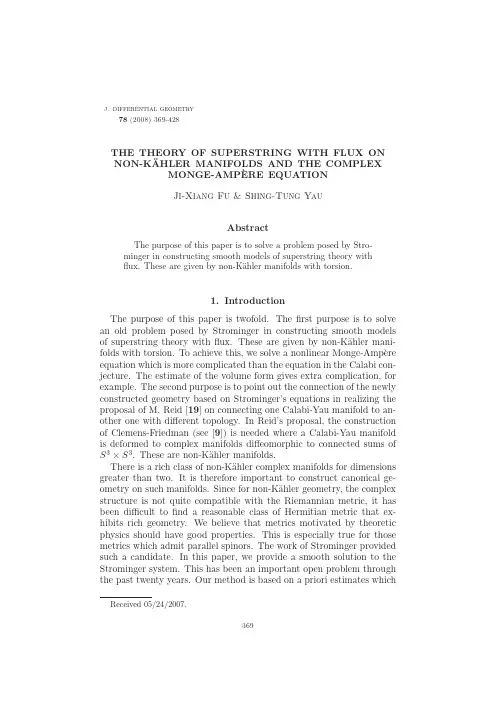
j.differential geometry78(2008)369-428THE THEORY OF SUPERSTRING WITH FLUX ON NON-K¨AHLER MANIFOLDS AND THE COMPLEXMONGE-AMP`ERE EQUATIONJi-Xiang Fu&Shing-Tung YauAbstractThe purpose of this paper is to solve a problem posed by Stro-minger in constructing smooth models of superstring theory withflux.These are given by non-K¨a hler manifolds with torsion.1.IntroductionThe purpose of this paper is twofold.Thefirst purpose is to solve an old problem posed by Strominger in constructing smooth models of superstring theory withflux.These are given by non-K¨a hler mani-folds with torsion.To achieve this,we solve a nonlinear Monge-Amp`e re equation which is more complicated than the equation in the Calabi con-jecture.The estimate of the volume form gives extra complication,for example.The second purpose is to point out the connection of the newly constructed geometry based on Strominger’s equations in realizing the proposal of M.Reid[19]on connecting one Calabi-Yau manifold to an-other one with different topology.In Reid’s proposal,the construction of Clemens-Friedman(see[9])is needed where a Calabi-Yau manifold is deformed to complex manifolds diffeomorphic to connected sums of S3×S3.These are non-K¨a hler manifolds.There is a rich class of non-K¨a hler complex manifolds for dimensions greater than two.It is therefore important to construct canonical ge-ometry on such manifolds.Since for non-K¨a hler geometry,the complex structure is not quite compatible with the Riemannian metric,it has been difficult tofind a reasonable class of Hermitian metric that ex-hibits rich geometry.We believe that metrics motivated by theoretic physics should have good properties.This is especially true for those metrics which admit parallel spinors.The work of Strominger provided such a candidate.In this paper,we provide a smooth solution to the Strominger system.This has been an important open problem through the past twenty years.Our method is based on a priori estimates whichReceived05/24/2007.369370J.-X.FU &S.-T.YAUcan be generalized to elliptic fibration over general Calabi-Yau mani-folds.However,in this paper,for the sake of importance in string the-ory,we shall restrict ourselves to complex three-dimensional manifolds.The structure of the equations for higher-dimensional Calabi-Yau man-ifolds is a little bit different.They are also more relevant to algebraic geometry and hence will be treated in a later occasion.The physical context of the solutions is discussed in a companion paper [3]written jointly with K.Becker,M.Becker,and L.-S.Tseng.Acknowledgement.The authors would like to thank K.Becker,M.Becker,and L.-S.Tseng for useful discussions.J.-X.Fu would also like to thank J.Li and X.-P.Zhu for useful discussions.J.-X.Fu is supported in part by NSFC grant 10471026.S.-T.Yau is supported in part by NSF grants DMS-0244462,DMS-0354737and DMS-0306600.2.Motivation from string theoryIn the original proposal for compactification of superstring [5],Can-delas,Horowitz,Strominger,and Witten constructed the metric prod-uct of a maximal symmetric four-dimensional spacetime M with a six-dimensional Calabi-Yau vacuum X as the ten-dimensional spacetime;they identified the Yang-Mills connection with the SU (3)connection of the Calabi-Yau metric and set the dilaton to be a constant.Adapting the second author’s suggestion of using Uhlenbeck-Yau’s theorem [22]on constructing Hermitian-Yang-Mills connections over stable bundles,Witten [23]and later Horava-Witten [13]proposed to use higher rank bundles for strong coupled heterotic string theory so that the gauge groups can be SU (4)or SU (5).At around the same time,Strominger [20]analyzed heterotic super-string background with spacetime supersymmetry and non-zero torsion by allowing a scalar “warp factor”for the spacetime metric.He consid-ered a ten-dimensional spacetime that is a warped product of a maximal symmetric four-dimensional spacetime M and an internal space X ;the metric on M ×X takes the form g 0=e 2D (y ) g μν(x )00g ij (y ),x ∈M,y ∈X ;the connection on an auxiliary bundle is Hermitian-Yang-Mills connec-tion over X :F ∧ω2=0,F 2,0=F 0,2=0.Here ωis the Hermitian form ω=√−12g i ¯j dz i ∧d ¯z j defined on the internal space X .In this system,the physical relevant quantities are h =−√−1(¯∂−∂)ω,φ=−12log Ω +φ0,THE THEORY OF SUPERSTRING 371and g 0ij=e 2φ0 Ω −1g ij ,for a constant φ0.In order for the ansatz to provide a supersymmetric configuration,one introduces a Majorana-Weyl spinor so thatδψM = M −18h MNP γNP =0,δλ=γM ∂M φ −112h MNP γMNP =0,δχ=γMN F MN =0,where ψM is the gravitino,λis the dilatino,χis the gluino,φis the dilaton and h is the Kalb-Ramond field strength obeyingdh =α 2(tr F ∧F −tr R ∧R ),where α is positive.Strominger [20]showed that in order to achieve spacetime supersymmetry,the internal six manifold X must be a com-plex manifold with a non-vanishing holomorphic three-form Ω;and the anomaly cancellation demands that the Hermitian form ωobey 1√−1∂¯∂ω=α 4(tr R ∧R −tr F ∧F )and supersymmetry requires 2d ∗ω=√−1(¯∂−∂)log Ω ω.Accordingly,he proposed the system(2.1)F H ∧ω2=0;(2.2)F 2,0H =F 0,2H =0;(2.3)√−1∂¯∂ω=α 4(tr R ∧R −tr F H ∧F H );(2.4)d ∗ω=√−1(¯∂−∂)ln Ω ω.This system gives a solution of a superstring theory with flux that allows a non-trivial dilaton field and a Yang-Mills field.(It turns out D (y )=φand is the dilaton field.)Here ωis the Hermitian form and R is the curvature tensor of the Hermitian metric ω;H is the Hermitian metric and F is its curvature of a vector bundle E ;tr is the trace of the endomorphism bundle of either E or T X .In [17],Li and Yau observed the following:1The curvature F of the vector bundle E in ref.[20]is real,i.e.,c 1(E )=F 2π.But we are used to taking the curvature F such that c 1(E )=√−12πF .So this equationcorrects eq.(2.18)of ref.[20]by a minus sign.2See eq.(56)of ref.[21],which corrects eq.(2.30)of ref.[20]by a minus sign.372J.-X.FU &S.-T.YAULemma 1.Equation (2.4)is equivalent to(2.5)d ( Ω ωω2)=0.In fact,Li and Yau gave the first irreducible non-singular solution of the supersymmetric system of Strominger for U (4)and U (5)prin-ciple bundle.They obtained their solutions by perturbing around the Calabi-Yau vacuum coupled with the sum of tangent bundle and triv-ial line bundles.In this paper,we consider the solution on complex manifolds which do not admit K¨a hler structures.Study of non-K¨a hler manifolds should be useful to understand the speculation of M.Reid that all Calabi-Yau manifolds can be deformed to each other through conifold transition.An example of non-K¨a hler manifolds X is given by T 2-bundles over Calabi-Yau varieties [2,4,10,12,14].Since we demand that the internal six manifold X is a complex manifold with a non-vanishing holomorphic three form Ω,we consider the T 2−bundle (X,ω,Ω)over a complex surface (S,ωS ,ΩS )with a non-vanishing holomorphic 2-form ΩS .According to the classification of complex surfaces by Enriques and Kodaira,such complex surfaces must be finite quotients of K3sur-face,complex torus (K¨a hler),and Kodaira surface (non-K¨a hler).If (X,ω,Ω)satisfies Strominger’s equation (2.4),Lemma 1shows thatd ( Ω ωω2)=0.Let ω= Ω 12ωω.Then dω 2=0,i.e.,ω is a balanced metric [18].The balanced metric was studied extensively by Michelsohn.She proved that the balanced condition is preserved under proper holomorphic submersions.Note that Alessandrini and Bassanelli [1]proved that this condition is also preserved under mod-ifications of complex manifolds.Hence if a holomorphic submersion πfrom a balanced manifold X to a complex surface S is proper,S is also balanced (actually π∗ω 2is the balanced metric on S ,see Proposition1.9in [18]).When the dimension of complex manifold is two,the condi-tions of being balanced and K¨a hler coincide.Hence there is no solution to Strominger’s equation (1.4)on T 2bundles over Kodaira surface and we consider T 2-bundles over K 3surface and complex torus only.On the other hand,duality from M -theory suggests that there is no supersymmetric solution when the base manifold is a complex torus (see[3]).This class of three manifolds includes the Iwasawa manifold.But the solution to Strominger’s system should exist when the base is K 3surface.In this paper we prove the existence of solutions to Strominger’s system on such torus bundles over K 3surfaces.3.Statement of main resultLet (S,ωS ,ΩS )be a K3surface or a complex torus with a K¨a hler form ωS and a non-vanishing holomorphic (2,0)-form ΩS .Let ω1and ω2be anti-self-dual (1,1)-forms such that ω12πand ω22πrepresent integralTHE THEORY OF SUPERSTRING 373cohomology ing these two forms,Goldstein and Prokushkin[10]constructed a non-K¨a hler manifold X such that π:X →S is aholomorphic T 2-fibration over S with a Hermitian form ω0=π∗ωS +√−12θ∧¯θand a holomorphic (3,0)-form Ω=ΩS ∧θ(for the definition of θ,see section 3).Note that (ω0,Ω)satisfies equation (2.5).(Sethipointed out that in papers [6]and [2]similar ansatz was discussed.However the major problem of solving equations was not addressed in the literature.)Let u be any smooth function on S and let ωu =π∗(e u ωS )+√−12θ∧¯θ.Then (ωu ,Ω)also satisfies equation (2.5)(see [10]or Lemma 12),i.e.,ωu is conformal balanced.The stability concept can be defined on a vector bundle over a complex manifold using the Gauduchon metric [16],and hence for complex manifolds with balanced metrics.Note that the stability concept of the vector bundle depends only on the conformal class of metric.Let V →X be a stable bundle over X with degree zero with respect to the metric ωu .(Such bundles can be obtained by pulling back stable bundles over a K 3surface or a complex torus,see Lemma 16.)According to Li-Yau’s theorem [16],there is a Hermitian-Yang-Mills metric H on V ,which is unique up to positive constants.The curvature F H of the Hermitian metric H satisfies equation (2.1)and (2.2).So (V,F H ,X,ωu )satisfies Strominger’s equations (2.1),(2.2)and (2.4).Therefore we only need to consider equation (2.3).As ω1and ω2are harmonic,¯∂ω1=¯∂ω2=0.According to ¯∂-Poincar´e Lemma,we can write ω1and ω2locally asω1=¯∂ξ=¯∂(ξ1dz 1+ξ2dz 2)and ω2=¯∂ζ=¯∂(ζ1dz 1+ζ2dz 2),where (z 1,z 2)is a local coordinate on S .Let B = ξ1+√−1ζ1ξ2+√−1ζ2.We can use B to compute tr R 0∧R 0of the metric ω0(see Proposition8)and tr R u ∧R u of the metric ωu (see Lemma 14).Then we reduce equation (2.3)to √−1∂¯∂e u ∧ωS −α 2∂¯∂(e −u tr(¯∂B ∧∂B ∗·g −1))−α 2∂¯∂u ∧∂¯∂u (3.1)=α 4tr R S ∧R S −α 4tr F H ∧F H −12( ω1 2ωS + ω2 2ωS )ω2S 2!,where g =(g i ¯j )is the Ricci-flat metric on S associated to the K¨a hler form ωS and g −1is the inverse matrix of g ;R S is the curvature of g .374J.-X.FU &S.-T.YAUTaking wedge product with ωu and integrating both sides of the above equation over X ,we obtain(3.2)α X {tr R S ∧R S −tr F H ∧F H }∧ωu −2 X( ω1 2ωS + ω2 2ωS )ω2S 2!∧ωu =0.When S =T 4,R S =0.We obtain immediatelyProposition 2.There is no solution of Strominger’s system on the torus bundle X over T 4if the metric has the form e u ωS +√−12θ∧¯θ.This situation is different if the base is a K 3surface.If E is a stable bundle over S with degree 0with respect to the metric ωS ,then V =π∗E is also a stable bundle with degree 0over X with respect to the Hermitian metric ωu .In this case,equation (3.1)on X can be considered as an equation on S .Integrating equation (3.1)over S ,(3.3)α S {tr R S ∧R S −tr F H ∧F H }=2 S ( ω1 2ωS + ω2 2ωS )ω2S 2!.As S tr R S ∧R S =8π2c 2(V )=8π2×24,and S tr F H ∧F H =8π2×(c 2(E )−12c 21(E ))≥0,we can rewrite equation (3.3)as (3.4)α 24− c 2(E )−12c 21(E ) = Sω12π 2ωS + ω22π 2ωS ω2S 2!.For a compact,oriented,simply connected four-manifold S ,the Poincar´e duality gives rise to a pairingQ :H 2(S ;Z )×H 2(S ;Z )→Zdefined byQ (β,γ)=S β∧γ.We shall denote Q (β,β)by Q (β).Then for an integral anti-self-dual (1,1)-form ω12π,the intersection number Q (ω12π)can be expressed as − Sω12π 2ω2S 2!.On the other hand,the intersection form on K 3surface isgiven by [7]3 0110⊕2(−E 8),where E 8=⎛⎜⎜⎜⎜⎜⎜⎜⎜⎜⎜⎝20−1020−1−102−1−1−12−1−12−1−12−1−12−1−12⎞⎟⎟⎟⎟⎟⎟⎟⎟⎟⎟⎠.THE THEORY OF SUPERSTRING375Hence Q(ω12π)∈{−2,−4,−6,...}.We shall use the following convention for vector bundles over a com-pact oriented four-manifold:κ(E)=c2(E)for SU(r)bundle E,=c2(E)−12c21(E)for U(r)bundle E,=−12p1(E)for SO(r)bundle E.Then(3.4)implies(3.5)α (24−κ(E))+Qω12π+Qω22π=0,which means that there is a smooth functionμsuch that(3.6)α4tr R S∧R S−α4tr F H∧F H−12( ω1 2+ ω2 2)ω2S2!=−μω2S2!andSμω22!=0.Inserting(3.6)into(3.1),we obtain the followingequation:(3.7)√−1∂¯∂e u∧ωS−α2∂¯∂(e−u tr(¯∂B∧∂B∗·g−1))−α2∂¯∂u∧∂¯∂u+μω2S2!=0,where tr(¯∂B∧∂B∗·g−1)is a smooth well-defined(1,1)-form on S.In particular,whenω2=nω1,n∈Z,tr(¯∂B∧∂B∗·g−1)=√−11+n24ω1 2ωSωS(see Proposition11).Hence if we set f=1+n24 ω1 2ωS,we can rewriteequation(3.7)as the standard complex Monge-Amp`e re equation:(3.8)Δ(e u−α2fe−u)+4αdet u i¯jdet g i¯j+μ=0,where u i¯j denotes∂2u∂z i∂¯z j and =2g i¯j∂2∂z i∂¯z j.We shall solve equation(3.7)by the continuity method[24].Our main theorem isTheorem3.The equation(3.7)has a smooth solution u such thatω =e uωS−α2√−1e−u tr(¯∂B∧∂B∗·g−1)+α√−1∂¯∂udefines a Hermitian metric on S.Our solution u satisfiesSe−4u14=A 1.Actually we can provethat inf u≥−ln(C1A)(see Proposition21)where A must be very small (see Proposition22)and our solution u must be very big.376J.-X.FU&S.-T.YAUTheorem 4.Let S be a K3surface with a Ricci-flat metricωS.Letω1andω2be anti-self-dual(1,1)-forms on S such thatω12π,ω22π∈H2(S,Z).Let X be a T2-bundle over S constructed byω1andω2.Let E be a stable bundle over S with degree0.Supposeω1,ω2andκ(E) satisfy condition(3.5).Then there exist a smooth function u on S and a Hermitian-Yang-Mills metric H on E such that(V=π∗E,π∗F H,X,ωu) is a solution of Strominger’s system.Since it is easy tofind(ω1,ω2,κ(E))which satisfies condition(3.5), this theorem providesfirst examples of solutions to Strominger’s system on non-K¨a hler manifolds.4.Geometric modelIn this section,we take the geometric model of Goldstein and Pro-kushkin for complex non-K¨a hler manifolds with an SU(3)structure[10]. We summarize their results as follows:Theorem5.[10]Let(S,ωS,ΩS)be a Calabi-Yau2-fold with a non-vanishing holomorphic(2,0)−formΩS.Letω1andω2be anti-self-dual(1,1)-forms on S such thatω12π∈H2(S,Z)andω22π∈H2(S,Z).Thenthere is a Hermitian3-fold X such thatπ:X→S is a holomorphic T2-fibration over S and the following holds:1.For any real1-formsα1andα2defined on some open subset of Sthat satisfy dα1=ω1and dα2=ω2,there are local coordinates x and y on X such that dx+idy is a holomorphic form on T2-fibers and a metric on X has the following form:(4.1)g0=π∗g+(dx+π∗α1)2+(dy+π∗α2)2,where g is a Calabi-Yau metric on S corresponding to the K¨a hler formωS.2.X admits a nowhere vanishing holomorphic(3,0)-form with unitlength:Ω=((dx+π∗α1)+i(dy+π∗α2))∧π∗ΩS.3.If eitherω1orω2represents a non-trivial cohomological class thenX admits no K¨a hler metric.4.X is a balanced manifold.The Hermitian form(4.2)ω0=π∗ωS+(dx+π∗α1)∧(dy+π∗α2)corresponding to the metric(4.1)is balanced,i.e.,dω20=0.5.Furthermore,for any smooth function u on S,the Hermitian met-ricωu=π∗(e uωS)+(dx+π∗α1)∧(dy+π∗α2)is conformal balanced.Actually(ωu,Ω)satisfies equation(2.5).THE THEORY OF SUPERSTRING 377Goldstein and Prokushkin also studied the cohomology of this non-K¨a hler manifold X :h 1,0(X )=h 1,0(S ),h 0,1(X )=h 0,1(S )+1;In particular,h 0,1(X )=h 1,0(X )+1.Moreover,b 1(X )=b 1(S )+1,when ω2=nω1,b 1(X )=b 1(S ),when ω2=nω1;b 2(X )=b 2(S )−1,when ω2=nω1,b 2(X )=b 2(S )−2,when ω2=nω1andχ(X )=0.The above topological results can be explained as follows.Let L 1be a holomorphic line bundle over S with the first Chern class c 1(L 1)=[−ω12π].Then we can choose a Hermitian metric h 1on L 1such that its curvature is √−1ω1.Let S 1={v ∈L 1|h 1(v,v )=1}which is a circle bundle over S .Locally we write ω1=dα1U for some real 1-form α1U on some open subset U on S .Such α1U define a connection on S 1,i.e.,there is a section ξU on S 1such that ξU =√−1α1U ⊗ξU .The section ξU defines a local coordinate x U on fibers of S 1|U ,i.e.,we can describe the circle S 1by e √−1x U ξU .If we write ω1=dα1V onanother open set V of S ,then there is another section ξV such that (4.3) ξV =√−1α1V ⊗ξVand this section ξV defines another coordinate x V on fiber of S 1|V .On U ∩V ,d (α1U −α1V )=0and there is a function f UV such that (4.4)d f UV =α1U −α1V .On the other hand,on U ∩V ,there is also a function g UV on U ∩V such that ξV =e √−1g UV ξU .We computeξV = (e √−1g UV ξU )=(√−1dg UV +√−1α1U )⊗(e √−1g UV ξU )=(√−1dg UV +√−1α1U )⊗ξV .Comparing the above equality with (4.3),we get(4.5)−dg UV =α1U −α1V .378J.-X.FU &S.-T.YAUSo combining (4.4),we find(4.6)g UV =f UV +c UV ,where c UV is some constant on U ∩V .On U ∩V ,from eix U ξU =e ix V ξV =e √−1x V e √−1g UV ξU ,we obtain(4.7)x U =x V +g UV +2kπ=x V +f UV +c UV +2kπ.(4.4)and (4.7)imply (4.8)dx U −dx V =d f UV =−α1U +α1V .So dx U +α1U is a globally defined 1-form on X .We denote it by dx +α1.We construct another line bundle L 2with the first Chern class [−ω22π].Similarly,we write locally ω2=dα2,and define a coordinate y on fibers such that dy +α2is a well-defined 1-form on the circle bundle S 1of L 2.On X ,ω1=d (dx +α1)and ω2=d (dy +α2),and so [ω1]=[ω2]=0∈H 2(X,R ).When ω2=nω1,d (n (dx +α1)−(dy +α2))=0.So[n (dx +α1)−(dy +α2)]∈H 1(X,R ).Finally we define θ=dx +α1+√−1(dy +α2).Then θis a (1,0)-form on X ,see [10]or the next section.Because d ¯θ=ω1−√−1ω2is a (1,1)-form on X ,its (0,2)-component ¯∂¯θ=0.So [¯θ]∈H 0,1¯∂(X )∼=H 1(X,O ).5.The calculation of tr R ∧RIn order to calculate the curvature R and tr R ∧R ,we express the Hermitian metric (4.1)in terms of a basis of holomorphic (1,0)vector fields.Hence we need to write down the complex structure of X .Let {U,z j =x j +√−1y j ,j =1,2}be a local coordinate in S .The horizontallifts of vector fields ∂∂x j and ∂∂y j ,which are in the kernel of dx +π∗α1and dy +π∗α2,are X j =∂∂x j −α1 ∂∂x j ∂∂x −α2 ∂∂x j ∂∂yfor j =1,2,Y j =∂∂y j −α1 ∂∂y j ∂∂x −α2 ∂∂y j ∂∂yfor j =1,2.The complex structure ˜Ion X is defined as ˜IXj =Y j ,˜IY j =−X j ,for j =1,2,˜I ∂∂x =∂∂y ,˜I ∂∂y =−∂∂x .THE THEORY OF SUPERSTRING 379LetU j=X j −√−1˜IX j =X j −√−1Y j ,U 0=∂∂x −√−1˜I ∂∂x =∂∂x −√−1∂∂y .Then {U j ,U 0}is the basis of the (1,0)vector fields on X .The metric (4.1)takes the following Hermitian form:(5.1) (g i ¯j )001as U 1and U 2are in the kernel of dx +π∗α1and dy +π∗α2.Let (5.2)θ=dx +√−1dy +π∗(α1+√−1α2).It’s easy to check that {π∗dz j ,θ}annihilates the {U j ,U 0}and is the basis of (0,1)-forms on X .So {π∗dz j ,θ}are (1,0)-forms on X .Certainly π∗dz j are holomorphic (1,0)-forms and θis not.We need to construct another holomorphic (1,0)-form on X .Because ω1and ω2are harmonic forms on S ,∂ω1=∂ω2=0.By ¯∂-Poincar´e Lemma,locally we can find (1,0)-forms ξ=ξ1dz 1+ξ2dz 2and ζ=ζ1dz 1+ζ2dz 2on S ,where ξi and ζj are smooth complex functions on some open set of S ,such that ω1=∂ξand ω2=∂ζ.Let θ0=θ−π∗(ξ+√−1ζ)=(dx +√−1dy )+π∗(α1+√−1α2)−π∗(ξ+√−1ζ).We claim that θ0is a holomorphic (1,0)-form.By our construction,θ0is the (1,0)-form.But dθ=d (dx +√−1dy +π∗(α1+√−1α2))=π∗(ω1+√−1ω2)is a (1,1)-form on X .So(5.3)∂θ=0and ∂θ=dθ=π∗(ω1+iω2).Thus,∂θ0=∂θ−∂π∗(ξ+√−1ζ)=π∗(ω1+√−1ω2)−π∗(ω1+√−1ω2)=0.So θ0is a holomorphic (1,0)-form and {π∗dz j ,θ0}forms a basis of holo-morphic (1,0)-forms on X .Letϕj =ξj +√−1ζj for j =1,2and˜U j =U j +ϕj U 0for j =1,2.Then {˜Uj ,U 0}is dual to {π∗dz j ,θ0}because U j is in the kernel of θ.It’s the basis of holomorphic (1,0)-vector fields.The metric g 0then380J.-X.FU&S.-T.YAU becomes the following Hermitian matrix:(5.4)H X=⎛⎝g1¯1+|ϕ1|2g1¯2+ϕ1ϕ2ϕ1g2¯1+ϕ2ϕ1g2¯2+|ϕ2|2ϕ2ϕ1ϕ21⎞⎠=g+B·B∗BB∗1,where g is the Calabi-Yau metric on S and B=(ϕ1,ϕ2)t.According to Strominger’s explanation in[20],when the manifold is not K¨a hler,we should take the curvature of Hermitian connection on the holomorphic tangent bundle T ing the metric(5.4),we computethe curvature to beR=∂(∂H X·H−1X)=R1¯1R1¯2R2¯1R2¯2,whereR1¯1=R S+∂B∧(∂B∗·g−1)+B·∂(∂B∗·g−1),R1¯2=−R S B+(∂g·g−1)∧∂B−∂B∧(∂B∗·g−1)B−B∂(∂B∗·g−1)B+B(∂B∗·g−1)∧∂B+∂∂B, R2¯1=∂(∂B∗·g−1),R2¯2=−∂(∂B∗·g−1)B+(∂B∗·g−1)∧∂B,and R S is the curvature of Calabi-Yau metric g on S.It is easy to check that tr(∂B∧(∂B∗·g−1)+B·∂(∂B∗·g−1))−∂(∂B∗·g−1)B+(∂B∗·g−1)∧∂B=0.So tr R=π∗tr R S.Proposition6([11]).The Ricci forms of the Hermitian connections on X and S have the relation tr R=π∗tr R S.Remark7.In the above calculation,we don’t use the condition that the metric g on S is Calabi-Yau.Proposition8.(5.5)tr R∧R=π∗(tr R S∧R S+2tr∂∂(∂B∧∂B∗·g−1)).Proof.Fix any point p∈S,we pick B such that B(p)=0.Otherwise, B(p)=0and we simply replace B by B−B(p).Hence in the calculation of tr R∧R at p,all terms containing the factor B will vanish.Thus tr R∧R=tr R S∧R S+2tr R S∧∂B∧(∂B∗·g−1)+2tr∂g·g−1∧∂B∧¯∂(∂B∗·g−1)+2tr∂∂B∧∂(∂B∗·g−1). Proposition8follows from the next two lemmas.q.e.d.THE THEORY OF SUPERSTRING381 Lemma9.tr∂∂(∂B∧∂B∗·g−1)=tr R S∧∂B∧(∂B∗·g−1)+tr∂g·g−1∧∂B∧¯∂(∂B∗·g−1)+tr∂∂B∧∂(∂B∗·g−1).Proof.tr∂∂(∂B∧∂B∗·g−1)=−tr∂(∂B∧∂(∂B∗·g−1))=tr∂∂B∧∂(∂B∗·g−1)+tr∂B∧∂(∂B∗∧∂g−1)=tr∂∂B∧∂(∂B∗·g−1)−tr∂B∧∂(∂B∗·g−1∧∂g·g−1)=tr∂∂B∧∂(∂B∗·g−1)−tr∂B∧∂(∂B∗·g−1)∧∂g·g−1+tr∂B∧(∂B∗·g−1)∧¯∂(∂g·g−1)=tr∂∂B∧∂(∂B∗·g−1)−tr∂B∧∂(∂B∗·g−1)∧∂g·g−1+tr∂B∧(∂B∗·g−1)∧R S=tr(∂∂B∧∂(∂B∗·g−1))+tr(R S∧∂B∧∂B∗·g−1)+tr(∂g·g−1∧∂B∧∂(∂B∗·g−1).q.e.d. Lemma10.tr(¯∂B∧∂B∗·g−1)is a well-defined(1,1)-form on S.Proof.We take local coordinates(U,z i)and(W,w j)on S such that U∩W=∅.Let J=(∂w i∂z j)and(ω1+√−1ω2)|U=∂(ϕ1dz1+ϕ2dz2)=∂ϕ1∧dz1+¯∂ϕ2∧dz2,(ω1+√−1ω2)|W=∂(γ1dw1+γ2dw2)=∂γ1∧dw1+¯∂γ2∧dw2.Then on U∩W,¯∂γ1¯∂γ2∧dw1dw2=¯∂ϕ1¯∂ϕ2∧dz1dz2.So¯∂ϕ1¯∂ϕ2=¯∂γ1¯∂γ2J.(5.6)On the other hand,we have(5.7)g(z)=J t g(w)J,382J.-X.FU &S.-T.YAUwhere g (z )=(g i ¯j (z ))and g (w )=(g i ¯j (w )).Then on U ∩W ,using (5.6),(5.7),we havetr ¯∂γ1¯∂γ2∧ ∂¯γ1∂¯γ2 ·g −1(w )=tr(J t )−1 ¯∂ϕ1¯∂ϕ2 ∧ ∂ϕ1∂ϕ2 ¯J −1·¯J ·g −1(z )·J t =tr ¯∂ϕ1¯∂ϕ2 ∧ ∂¯ϕ1∂¯ϕ2 ·g −1(z ),which proves that tr(¯∂B∧∂B ∗·g −1)is a well-defined (1,1)-form on S .q.e.d.Although tr(¯∂B∧∂B ∗·g −1)is a well-defined (1,1)-form on S ,we can not express it by ω1and ω2.But in some particular cases,we can.Proposition 11.When ω2=nω1,n ∈Z ,(5.8)tr(¯∂B ∧∂B ∗·g −1)=√−14(1+n 2) ω1 2ωS ωS ,where g is the given Calabi-Yau metric on S and ωS is the corresponding K¨a hler form.Proof.We recall that locally,ω1=¯∂ξ,ξ=ξ1dz 1+ξ2dz 2,ω2=¯∂ζ,ζ=ζ1dz 1+ζ2dz 2,ϕj =ξj +√−1ζj ,for j =1,2,B = ϕ1ϕ2,B ∗= ¯ϕ1¯ϕ2 .When ω2=nω1,we take ζ=nξ.Then ¯∂ζj =n ¯∂ξj ,¯∂B= ¯∂ϕ1¯∂ϕ2 =(1+n √−1) ¯∂ξ1¯∂ξ2 and∂B ∗= ∂¯ϕ1∂¯ϕ2 =(1−n √−1) ∂¯ξ1∂¯ξ2 .THE THEORY OF SUPERSTRING 383Using above equalities,we find(5.9)tr(¯∂B ∧∂B ∗·g −1)=(1+n 2)tr ¯∂ξ1¯∂ξ2 ∧ ∂¯ξ1∂¯ξ2 ·g −1=1+n 2det g tr ∂ξ1∂¯z i d ¯z i ∂ξ2∂¯z i d ¯z i ∧ ∂ξ1∂¯z j dz j ∂ξ2∂¯z j dz j · g 2¯2−g 1¯2−g 2¯1g 1¯1 =1+n 2det g tr ∂ξ1∂¯z i ∂ξ2∂¯z i∧ ∂ξ1∂¯z j ∂ξ2∂¯z j · g 2¯2−g 1¯2−g 2¯1g 1¯1 d ¯z i ∧dz j .In order to get the global formula,we need to calculate ω1.As ω1is real,(5.10)∂ξi ∂¯z j =−∂ξj ∂¯z i for i,j =1,2.Since ω1is anti-self-dual,i.e.,ω1∧ωS =0,we have(5.11)g 1¯1∂ξ2∂¯z 2+g 2¯2∂ξ1∂¯z 1−g 1¯2∂ξ2∂¯z 1−g 2¯1∂ξ1∂¯z 2=0.Because(5.12)ω1∧ω1=−ω1∧∗ω1=−ω1∗¯ω1=− ω1 2ωS ω2S 2!,locally we also have (5.13)1det(g ) ∂ξ1∂¯z 1∂ξ2∂¯z 2−∂ξ1∂¯z 2∂ξ2∂¯z 1=18ω1 2ωS .Now using above (5.10),(5.11)and (5.13),we calculate the component of d ¯z 1∧dz 1in (5.9)to be(5.14)1+n 2det(g ) g 2¯2∂ξ1∂¯z 1∂ξ1∂¯z 1−g 2¯1∂ξ1∂¯z 1∂ξ2∂¯z 1−g 1¯2∂ξ2∂¯z 1∂ξ1∂¯z 1−g 1¯1∂ξ2∂¯z 1∂ξ2∂¯z 1 =1+n 2det(g ) ∂ξ1∂¯z 1 g 1¯1∂ξ2∂¯z 2+g 2¯2∂ξ1∂¯z 1 −g 2¯2 ∂ξ1∂¯z 1 2−g 1¯1∂ξ2∂¯z 1∂ξ1∂¯z 2 =1+n 2det(g )g 1¯1 ∂ξ1∂¯z 1∂ξ2∂¯z 2−∂ξ2∂¯z 1∂ξ1∂¯z 2=1+n 28ω1 2ωS g 1¯1.Similarly,the components of d ¯z 2∧dz 1,d ¯z 1∧dz 2and d ¯z 2∧dz 2in (5.9)are 1+n 28 ω1 2ωS g 1¯2,1+n 28 ω1 2ωS g 2¯1and 1+n 28ω1 2ωS g 2¯2respectively.384J.-X.FU &S.-T.YAUSo we obtaintr(¯∂A ∧∂A ∗·g −1)=√−11+n 24ω1 2ωS ωS .q.e.d.6.Reduction of Strominger’s systemConsider a 3-dimensional Hermitian manifold (X,ω0,Ω)as described in the section 2.Let ωS be the Calabi-Yau metric on S .Let θ=dx +α1+√−1(dy +α2),then the Hermitian form ω0in (4.2)is ω0=π∗ωS +√−12θ∧¯θ.Because Ω ω=1,and ω1and ω2are anti-self-dual,we use (5.3)to computed ( Ω ω0ω20)(6.1)=d (π∗ω2S +√−1π∗ωS ∧θ∧¯θ)=√−1π∗ωS ∧dθ∧¯θ−√−1π∗ωS ∧θ∧d ¯θ=√−1π∗ωS ∧((ω1+√−1ω2)∧¯θ−(ω1−√−1ω2)∧θ)=0.According to Lemma 1,(ω0,Ω)is the solution of equation (2.4).Let u be any smooth function on S and let (6.2)ωu =π∗(e u ωS )+√−12θ∧¯θ.Then Ω 2ωu =ω30ω3u =1e2u andΩ ωu ω2u =ω20+(e u −1)ω2S .Using (6.1),we obtaind ( Ω ωu ω2u)=dω20+d (e u −1)∧ω2S =0because e u is a function on S .Hence we have proven the followingLemma 12([10]).The metric (6.2)defined on X satisfies equation (2.5)and so satisfies equation (2.4).Let V be a stable vector bundle over X with degree 0with respec-tive to the metric ωu .According to Li-Yau’s theorem [16],there is a Hermitian-Yang-Mills metric H on V ,which is unique up to constant.THE THEORY OF SUPERSTRING 385Then (V,H,X,ωu )satisfies equation (2.1),(2.2)and (2.4)of the Stro-minge’s system.Hence to look for a solution to Strominger’s system,we need only to consider equation (2.3):(6.3)√−1∂¯∂ωu =α 4(tr R u ∧R u −tr F H ∧F H ),where R u is the curvature of Hermitian connection of metric ωu on the holomorphic tangent bundle T X .Define the Laplacian operator with respective to the metric ωS asψω2S 2!=√−1∂¯∂ψ∧ωS .Lemma 13.√−1∂¯∂ωu = e u ·ω2S 2!+12( ω1 2ωS + ω2 2ωS )ω2S 2!ing (5.3)and (5.12),we compute √−1∂∂ωu =√−1∂∂(e u ωS +√−12θ∧θ)=√−1∂¯∂e u ∧ωS −12¯∂θ∧∂¯θ= e u ·ω2S 2!+12( ω1 2ωS + ω2 2ωS )ω2S 2!.q.e.d.Lemma 14.tr R u ∧R u =π∗tr R S ∧R S +2√−1π∗(∂¯∂u ∧∂¯∂u )+2π∗(∂¯∂(e −u ρ)),where ρ=−√−1tr(¯∂B∧∂B ∗·g −1).Proof.In the proof of Proposition 8we don’t use the condition thatωS is K¨a hler.So if we replace metric g by e u g ,we can still obtain:(6.4)tr R u ∧R u =π∗(tr R u S∧R u S +2√−1∂¯∂(e −u ρ)),here R u S denotes the curvature of Hermitian connection of the metric e u g on holomorphic tangent bundle T S .SoR u S=¯∂∂u ·I +R S and(6.5)tr R u S∧R u S =tr R S ∧R S +2∂¯∂u ∧∂¯∂u,here we use the fact that tr R S =0because the Hermitian metric g is the Calabi-Yau metric on S .Inserting (6.5)into (6.4),we have proven the lemma.q.e.d.From Lemma 13and 14,we can rewrite equation (6.3)as(6.6)√−1∂¯∂e u ∧ωS −√−1α 2∂¯∂(e −u ρ)−α 2∂¯∂u ∧∂¯∂u =α 4tr R S ∧R S −α 4tr F H ∧F H −12( ω1 2+ ω2 2ωS )ω2S 2!.。

arXiv:hep-th/9612141v1 12 Dec 1996US-FT-48/96hep-th/9612141
OrbifoldsofM-TheoryandTypeIIStringTheoriesinTwoDimensions
ShibajiRoy∗DepartamentodeF´ısicadePart´ıculasUniversidadedeSantiago,E-15706SantiagodeCompostela,Spain
ABSTRACTWeconsiderseveralorbifoldcompactificationsofM-theoryandtheircorrespondingtypeIIdualsintwospace-timedimensions.Inparticular,weshowthatwhiletheorbifoldcompactificationofM-theoryonT9/J9isdualtotheorbifoldcompactificationoftypeIIBstringtheoryonT8/I8,thesameorbifoldT8/I8oftypeIIAstringtheoryisdualtoM-theorycompactifiedonasmoothproductmanifoldK3×T5.Similarly,whiletheorbifoldcompactificationofM-theoryon(K3×T5)/σ·J5isdualtotheorbifoldcompactificationoftypeIIBstringtheoryon(K3×T4)/σ·I4,thesameorbifoldoftypeIIAstringtheoryisdualtotheorbifoldT4×(K3×S1)/σ·J1ofM-theory.ThespectrumofvariousorbifoldcompactificationsofM-theoryandtypeIIstringtheoriesonbothsidesarecomparedgivingevidenceinfavorofthesedualityconjectures.WealsocommentonaconnectionbetweenDasgupta-Mukhi-WittenconjectureandDabholkar-Park-Senconjectureforthesix-dimensionalorbifoldmodelsoftypeIIBstringtheoryandM-theory.1.Introduction:Duringlastoneyearorsoalargenumberofdualpairsinvolvingstringtheories[1–10],M-theory[11–13]andF-theory[14,15]havebeenconstructedbyassumingthattheorbifoldingprocedurecommuteswithduality.Inthisprocess,onceadualpairisidentifiedonecanobtainanotherdualpairbyfurthercompactifyingthetheoriesonaninternalmanifoldMandthenmoddingouttheoriginalpairsbyacombinedgroupofdiscretesymmetriesrepresentinganinternalsymmetrytransformationoftheoriginaltheoriesaswellasanygeometricaction(s)ontheinternalmanifold.Thereare,however,notableexampleswherethisprocedurebreaksdown.Infact,allthedifferentcasesofconstructingdualpairsthroughorbifoldingprocedurehavebeenclassifiedbySen[9].Theyfallintothreecategoriesdependingonwhetherthegeometricaction‘s’actsfreely(withoutfixedpoints)ontheinternalmanifoldMornotorwhetheritactstriviallyonMandhasbeenreferredtoascategories1,2and3respectively.(TherearesomesubtletiesinvolvedinthisprocedureformoregeneralorbifoldgroupZNwithN>2[16–20].)Thecaseswhereorbifoldingprocedureisknownnottocommutewithdualityfallintocategory3[9].Ithasbeenshownin[9]throughanumberofexamplesinstringtheory,thatthisprocedureofobtainingdualpairsworksforthecases1and2.Oneoftheinterestingaspectsofthisclassificationisthatwhentheorbifoldingprocedurefallsintocategories1and2,itgivessensibledualpairsevenwhentheoriginaldualpairsinvolveM-theory(ifwetakeM-theorybydefinitionasthestrongcouplingorthelargeradiuslimitoftypeIIAstringtheory)andwasalsoemphasizedin[12].ThisisquiteremarkablesincethiswayonecanconnectvariouscompactificationsofM-theorytotheknowncompactificationsofstringtheoryandextractcertainpropertiesoftheformerwithoutknowingmuchaboutitsworldvolumetheory.Inthispaper,westudyexamplesofdualpairsinvolvingM-theoryandtypeIIstringtheoriesintwodimensionswhichcanbeobtainedfromtheM-theorydefinition∗(i.e.theequivalenceofM-theorycompactifiedonS1andtypeIIAstringtheorywhentheradiusofthecirclegoestozero)throughorbifoldingprocedureofcategory2intheclassificationmadebySen.IthasbeenconjecturedbyDasguptaandMukhi[22]andalsobySen[12]thatthetwodimensionalorbifoldmodelT9/{1,J9}ofM-theoryisequivalenttothetwodimensionalorbifoldmodelT8/{1,I8}oftypeIIBtheory,whereJ9changesthesignofthecoordinatesofT9aswellasthesignofthethree-formgaugefieldpresentinM-theory,whereasI8simplychangesthesignofthecoordinatesofT8.EquivalenceofthesetwomodelsfollowsfromtheM-theorydefinitionandthroughtheorbifoldingprocedureofcategory2.Bycomparingthemasslessspectrumonbothsides,wegivefurtherevidenceinfavorofthisconjecture.WeshowthatthistwodimensionaltypeIIBmodelhasagravitymultipletand8scalarmultipletsasmasslessspectrumintheuntwistedsector.Inthetwistedsectorithas256antichiralbosonscomingfromthe256fixedpointsoftheorbifoldandremaininertunder(0,16)supersymmetryofthemodel.AnidenticalspectrumhasbeenobtainedintheM-theoryorbifoldmodelonT9/{1,J9}inref.[22].Ithasbeennotedinref.[17],thattheorbifoldT8/{1,I8}oftypeIIBtheorycannotbesmoothedouttoanyknownmanifoldunliketheorbifoldT4/{1,I4}whichisknowntogiveasmoothmanifoldK3.ThesituationisdifferentfortypeIIAcompactificationonthesameorbifold,namely,T8/{1,I8}.Inthiscase,weshowtheequivalencebetweentypeIIAmodelonT8/{1,I8}andK3×T4.Infact,thistypeIIAorbifoldmodelisequivalenttoheteroticstringtheoryonT8,typeItheoryonT8,typeIIA(ortypeIIB)theoryonK3×T4,M-theoryonT4×T5/{1,J5}andM-theoryonK3×T5.WethusfindtheequivalenceoftypeIIAtheorycompactifiedontwocompletelydifferentinternalspacesnamely,oneisanorbifoldandtheotherisasmoothproductmanifold.WealsoshowhowthespectrumoftypeIIAtheoryonT8/{1,I8}canbereproducedfromtheK3×T4compactification.IntheformercaseasalsoshownbySen[9]thereisatadpolecontribution[23,24]sincetheEulercharactersiticoftheinternalspaceT8/{1,I8}isnon-zerowhereasinthelattercasethereisnotadpolesincetheEulercharacteristicofK3×T4iszero.Next,weconsideranothertwodimensionalorbifoldmodel(K3×T5)/{1,σ·J5}ofM-theory,whereJ5changesthesignofallthecoordinatesofT5andthethree-formgaugefieldinM-theory.Weshowthatthismodelisequivalenttoanorbifoldmodel(K3×T4)/{1,σ·I4}oftypeIIBstringtheory,whereI4simplychangesthesignoftheco-ordinatesofT4.Thisequivalencecanalsobeunderstood,asbefore,throughorbifoldingprocedureontheM-theorydefinitionandtheorbifoldingprocedureagainfallsintocat-egory2ofSen’sclassification.Themasslessspectrum[25]ontheM-theorysidecomingfromtheuntwistedsectorinthiscaseconsistsofagravitymultipletand16mattermul-